DANCING
WITH A WILD HORSE
MONDAY,
NOVEMBER 9, 2009
Tracking
the wild horses in Theodore Roosevelt National Park in a roundup year is
difficult when you don't plan to buy any at the sale, but 2009 was particularly
emotional knowing we did plan to take some home. I didn't want to get attached
to any one for fear the youngster may not make it until fall with all
the perils in the park. Then, there was the worry that they might be injured
during the roundup or at the sales barn. I tried to keep an open mind,
not deciding on any particular horses until I knew they were safe,
but it didn't work. We had decided we could take as many as four if need be,
but would definitely want as least two so that we would each have a
backup for the horses we ride for the tracking.
By mid-summer I had a few favorites. The first to snuggle his way into my heart was Marquis. I had always loved his sire, High Star, and his dam, Pale Lady. Little Marquis was just too cute with his wispy soft mane, dun color, and noble blaze. He was well built and fine featured like his sire and, though not representative of the characteristic colors of the park, I could see him fitting just fine in our pasture. In order to keep him company he needed a brother from the same band. His full brother, Sage, had always been a favorite of mine, but I didn't think we had the skills to deal with a two year old stallion. The yearling, Hawk, had caught my eye as well. Yearlings are notoriously awkward and even a little homely and Hawk was no exception, but under his rough appearance he was well built like his parents. He also had a bay roan coat, the characteristic white face, and a flashing blue eye. He's the kind of color people either love or hate; I grew to love him.
I had always thought I would like to have a foal from Thunder's band. A full brother to High Star, he is powerful, one of the larger stallions in the park, short coupled, and nicely balanced. He had two nice colts from last year, but we already had a yearling on the wish list, so wondered what he might have this year. His is one of the most elusive bands, claiming their territory on the bottoms west of the far eastern rim, but finally, at the end of June, we saw the band from Buck Hill and watched them with the scope as they climbed the butte onto the flats on the east side of the park. Could we get there to see them before dark? We had to try since we could make out the form of a very small foal with them. We got to the east side just as the sun was setting, but it was light enough to see the band and get a few shots as they swirled around us in the near darkness. There was the foal with Rain, a tiny dark colt with a large round star perfectly placed in the middle of his forehead. Henry and I had been caught in a rain storm and hailed on the day before. The colt's sire was Thunder Cloud and his dam was Rain; he had to be Hail!
We didn't see Hail again until the end of September. Fortunately for us, they were on Lindbo Flats with dozens of others. Again, it was nearing sunset, but it was unseasonably warm and quiet. Redface and Singlefoot were off to the east, but Blaze and several bachelors, including Sage and Hawk, were near the fence where we slid under to get a better look. Thunder eyed us cautiously from a small butte a few hundred yards to the south as we enjoyed the antics of the bachelors. Finally, determining we were no threat to him and his family, Thunder paraded them right to us. We watched as he sparred with a couple bachelors with his son, Clipper, closely following him. I marveled at the chance to see Thunder so close, and along with him, little Hail, three months old and stunningly beautiful! His dark coat had turned to blue, just like his daddy's and his legs were long and strait. He went to the top of the list with Marquis.
With Blaze was little Talkington, also a handsome blue roan. He would be smaller than Hail, but a good match for color. The thought of a team of blues crossed my mind. I also loved little Griggs from Red Face's band. He was an adorable bay roan with an engaging temperament. When High Star unexpectedly disappeared, my thoughts went back to his band and little Barnhart, another blue roan with a tiny star. I would have to see them come in and make my final decisions then.
At the roundup, we were successful in bringing in all the mares and foals; that is, all but Pale Lady and Marquis. Pale Lady slipped away from the choppers when they brought in the rest of her band. Though they were just south of the handling facility when the last run was made, it was too rainy to see them and they were missed again. We thought, maybe it was meant to be that Marquis would stay in the park. We hoped one day he would be a strong band sire like his father and brother.
All the others came in safe and strong. Since there were so many people coming to buy, we decided to buy two or three. Hail, Hawk, and Talkington were on the list. My friends, the Buffalo Gals, were there to support us and Joan had agreed to bid for me, since I was to be up in the box with the auctioneers, still IDing horses. At first I told Joan to buy them for whatever it took. It didn't take long to realize I was being foolish; I had Henry give her a limit. The foals were first and bringing unbelievable prices. I swallowed hard as Hail entered the ring. Joan bid like a pro. I could just see her over the head of one of the auctioneers. The bidding was lively and the price crept up. It was up to my limit; I nodded to Joan to keep bidding. Crazy or not, I wanted that colt. Joan made another bid with my nod; the auctioneer went on and on begging for another bid. Enough, enough, I cried to myself as he seemed to try too hard to outbid me, but Joan had prevailed and Hail was mine! Takington was next; I had fallen in love with the little tyke when he stood so quietly to have his blood drawn for the Coggins test. Again the price crept up and up. I knew Hawk was waiting with the other yearlings. I really wanted him, so I finally let Talkington go. I didn't know who was bidding at the time, but found out later that a very nice lady from MN had bought him and would give him a wonderful home.
Hawk was next. For all his wild looks, he was handsome and proud. Though he was extremely frightened, he kept his cool in that noisy foreign place. Joan was watching as the bidding started, but didn't want to seem too eager, so hung back a bit. Renee jabbed her in the ribs with an elbow, thinking she was preoccupied and missing out on the colt. Joan nonchalantly lifted her number. Up the bid climbed again, but stopped below my limit. The other colt I wanted so badly, a son of the great High Star who had recently died, and Pale Lady who had been the only mare crafty enough to evade capture, was coming home with me. Now I could relax.
By mid-summer I had a few favorites. The first to snuggle his way into my heart was Marquis. I had always loved his sire, High Star, and his dam, Pale Lady. Little Marquis was just too cute with his wispy soft mane, dun color, and noble blaze. He was well built and fine featured like his sire and, though not representative of the characteristic colors of the park, I could see him fitting just fine in our pasture. In order to keep him company he needed a brother from the same band. His full brother, Sage, had always been a favorite of mine, but I didn't think we had the skills to deal with a two year old stallion. The yearling, Hawk, had caught my eye as well. Yearlings are notoriously awkward and even a little homely and Hawk was no exception, but under his rough appearance he was well built like his parents. He also had a bay roan coat, the characteristic white face, and a flashing blue eye. He's the kind of color people either love or hate; I grew to love him.
I had always thought I would like to have a foal from Thunder's band. A full brother to High Star, he is powerful, one of the larger stallions in the park, short coupled, and nicely balanced. He had two nice colts from last year, but we already had a yearling on the wish list, so wondered what he might have this year. His is one of the most elusive bands, claiming their territory on the bottoms west of the far eastern rim, but finally, at the end of June, we saw the band from Buck Hill and watched them with the scope as they climbed the butte onto the flats on the east side of the park. Could we get there to see them before dark? We had to try since we could make out the form of a very small foal with them. We got to the east side just as the sun was setting, but it was light enough to see the band and get a few shots as they swirled around us in the near darkness. There was the foal with Rain, a tiny dark colt with a large round star perfectly placed in the middle of his forehead. Henry and I had been caught in a rain storm and hailed on the day before. The colt's sire was Thunder Cloud and his dam was Rain; he had to be Hail!
We didn't see Hail again until the end of September. Fortunately for us, they were on Lindbo Flats with dozens of others. Again, it was nearing sunset, but it was unseasonably warm and quiet. Redface and Singlefoot were off to the east, but Blaze and several bachelors, including Sage and Hawk, were near the fence where we slid under to get a better look. Thunder eyed us cautiously from a small butte a few hundred yards to the south as we enjoyed the antics of the bachelors. Finally, determining we were no threat to him and his family, Thunder paraded them right to us. We watched as he sparred with a couple bachelors with his son, Clipper, closely following him. I marveled at the chance to see Thunder so close, and along with him, little Hail, three months old and stunningly beautiful! His dark coat had turned to blue, just like his daddy's and his legs were long and strait. He went to the top of the list with Marquis.
With Blaze was little Talkington, also a handsome blue roan. He would be smaller than Hail, but a good match for color. The thought of a team of blues crossed my mind. I also loved little Griggs from Red Face's band. He was an adorable bay roan with an engaging temperament. When High Star unexpectedly disappeared, my thoughts went back to his band and little Barnhart, another blue roan with a tiny star. I would have to see them come in and make my final decisions then.
At the roundup, we were successful in bringing in all the mares and foals; that is, all but Pale Lady and Marquis. Pale Lady slipped away from the choppers when they brought in the rest of her band. Though they were just south of the handling facility when the last run was made, it was too rainy to see them and they were missed again. We thought, maybe it was meant to be that Marquis would stay in the park. We hoped one day he would be a strong band sire like his father and brother.
All the others came in safe and strong. Since there were so many people coming to buy, we decided to buy two or three. Hail, Hawk, and Talkington were on the list. My friends, the Buffalo Gals, were there to support us and Joan had agreed to bid for me, since I was to be up in the box with the auctioneers, still IDing horses. At first I told Joan to buy them for whatever it took. It didn't take long to realize I was being foolish; I had Henry give her a limit. The foals were first and bringing unbelievable prices. I swallowed hard as Hail entered the ring. Joan bid like a pro. I could just see her over the head of one of the auctioneers. The bidding was lively and the price crept up. It was up to my limit; I nodded to Joan to keep bidding. Crazy or not, I wanted that colt. Joan made another bid with my nod; the auctioneer went on and on begging for another bid. Enough, enough, I cried to myself as he seemed to try too hard to outbid me, but Joan had prevailed and Hail was mine! Takington was next; I had fallen in love with the little tyke when he stood so quietly to have his blood drawn for the Coggins test. Again the price crept up and up. I knew Hawk was waiting with the other yearlings. I really wanted him, so I finally let Talkington go. I didn't know who was bidding at the time, but found out later that a very nice lady from MN had bought him and would give him a wonderful home.
Hawk was next. For all his wild looks, he was handsome and proud. Though he was extremely frightened, he kept his cool in that noisy foreign place. Joan was watching as the bidding started, but didn't want to seem too eager, so hung back a bit. Renee jabbed her in the ribs with an elbow, thinking she was preoccupied and missing out on the colt. Joan nonchalantly lifted her number. Up the bid climbed again, but stopped below my limit. The other colt I wanted so badly, a son of the great High Star who had recently died, and Pale Lady who had been the only mare crafty enough to evade capture, was coming home with me. Now I could relax.
MONDAY, NOVEMBER 9, 2009
TRAINING THE BABIES
I have lived a lot of
years and trained a few horses, but none are more fascinating than
the wild horses from the park. They are essentially blank slates with very
little, if any, close up experience with humans. Oh, they've seen us in the
park and had the unpleasant experience of being pushed though chutes, sales
rings, trailers, and pens, so they have had some good and not so good
experience with us, but horses are generally very forgiving and oh, so curious.
Most of us who have weanlings are petting them and getting them to trust us. Some owners report having their babies halter broken already. A lot depends on the temperament of the individual and the amount of time one is able to spend with the little newcomer.
A weanling is always very curious, but also frightened of these two legged predators who have captured him and seemed bent on putting their paws on him. Working a baby is much different from working an older horse. One does not want to push him very fast or very long, as he can injure his delicate legs. I recommend John Lyons' book, Bringing Up Baby. It gives step-by-step lessons for training a foal in its first year without injury to either the foal or the handler.
Our little Hail, the third wild weanling I've gentled, has been a joy to work with. He was, at first, very frightened, but careful, patient work in the round pen soon paid off. First teaching him that I was dominant yet trustworthy, I was able to get him to walk, turn, stop, face me, and eventually let me touch him. At first it was less frightening for him to touch with a training stick, but that led to being able to scratch and pet him with a hand. He now lets me touch him all over from both sides. It is very important to train both sides. Little Hail now comes to me for his scratches, as he has learned that the two legs can be pretty good friends. Recently, I was working with Griggs, the other weanling we are keeping; I had put Hail in a smaller round pen to wait his turn to "play." It soon became clear to me that Hail wasn't being so patient for his scratching. He was running around the little pen bucking and kicking alternately with pawing at the fence between us and trying to stick his head through it. Once I let Griggs out of the big pen and opened the gate to Hail's pen, he went right in and waited for his scratches!
Most of us who have weanlings are petting them and getting them to trust us. Some owners report having their babies halter broken already. A lot depends on the temperament of the individual and the amount of time one is able to spend with the little newcomer.
A weanling is always very curious, but also frightened of these two legged predators who have captured him and seemed bent on putting their paws on him. Working a baby is much different from working an older horse. One does not want to push him very fast or very long, as he can injure his delicate legs. I recommend John Lyons' book, Bringing Up Baby. It gives step-by-step lessons for training a foal in its first year without injury to either the foal or the handler.
Our little Hail, the third wild weanling I've gentled, has been a joy to work with. He was, at first, very frightened, but careful, patient work in the round pen soon paid off. First teaching him that I was dominant yet trustworthy, I was able to get him to walk, turn, stop, face me, and eventually let me touch him. At first it was less frightening for him to touch with a training stick, but that led to being able to scratch and pet him with a hand. He now lets me touch him all over from both sides. It is very important to train both sides. Little Hail now comes to me for his scratches, as he has learned that the two legs can be pretty good friends. Recently, I was working with Griggs, the other weanling we are keeping; I had put Hail in a smaller round pen to wait his turn to "play." It soon became clear to me that Hail wasn't being so patient for his scratching. He was running around the little pen bucking and kicking alternately with pawing at the fence between us and trying to stick his head through it. Once I let Griggs out of the big pen and opened the gate to Hail's pen, he went right in and waited for his scratches!
MONDAY, DECEMBER
14, 2009
As much fun as the little guys are, they do not compare with the older ones. Hawk, the yearling, has taught me so much in just a few weeks. I feel so privileged to have this exquisite wild creature in my barnyard. I literally can't wait to get to work with him every day and I think he is beginning to enjoy our sessions as much as I do.
First I should tell a little more about Hawk and his life up
until the roundup. In June of 2008, Hawk was born into a band of around a dozen
horses; he lived relatively peacefully in the breaks of the Little Missouri
River. In a good year, the grass grows
tall and water is plentiful in the valleys lined with Juniper on the south and
often bare bentonite to the north.
Both High Star and Pale Lady were wary horses. High Star, the
harem stallion, always stood on higher ground watching for predators. Pale Lady was the lead mare, ready to lead
the band away at a full gallop if danger appeared. Hawk had his full brother,
as well as other young band mates to play with.
That winter was a cold and snowy one, but they all survived and welcomed
the warm days and tender green grass of another spring. New foals were born and life seemed ideal for
the band in the summer of 2009.
Then unexpectedly, High Star disappeared in September. No one has ever determined what happened to
him, but life would never be the same for his band. Other stallions vied for the mares and the
young stallions, considered threats, were driven away. Hawk sustained deep bites on both sides of
his neck and one on his right hock, either from the new harem stallion or from
the bachelors, who initiated him into the “Young Guns” band. He was just beginning to find his place in
that band when the helicopters thumped overhead and life again changed forever.
In the 17 months of his life, Hawk had learned well from his
parents. When I started to work with
him, he was convinced that these predators outside his pen were out to get
him. At first he jumped and ran to the other side of the pen every time he saw
us or heard our footsteps in the gravel. The first couple weeks were spent just
getting him used to having people around him. We would sit near his 6 foot high
pen and near his feed, walk around on the outside of the pen, and finally clean
it with him in it, but that sent him churning around the pen, looking for a way
to flee from me.
I had to try something else. My friend had said to put a gentle horse in with him so that he could take his cues from that horse. I tried working a gentle horse in the same pen, but that really frightened him, so I had to think of some better plan that would help him relax. Finally, I hopped on my big, gentle dressage horse with, at first, no saddle or bridle and road him around in the round pen with Hawk. Maestro was so relaxed that Hawk soon accepted him and me on his back. I was able to work the youngster around the pen, pushing him when he ran from us and stopping and taking the pressure off him when he stopped. The pen was a little too small to get him to face us, so I just took advantage of the stopping and standing. At first, just moving a finger would send him racing away from us. As he became accustomed to the movement of one finger, two fingers, a hand, an arm, and two arms, I was finally able to use a training stick as an extension of my arm. Before long, I was able to swing the stick around, up and down and slap its string against the ground and the rails. With rhythmic movements, I could make it approach and retreat from him until I could finally touch him and scratch him with it. Maestro's ability to side pass made it easy to slide up to Hawk without frightening him. Within a week of taking Maestro into the pen, I was able to go through the ritual of moving Hawk, stopping him, snapping the whip around, touching him with it and ending with scratching him with my hand. A couple weeks of this along with cleaning his pen twice a day helped Hawk adjust to having me closer to him, so it was time to try it on foot.
The minute I would walk into his pen without the wheel barrow, he would circle the pen with his head in the air. That was good, because one of the first things I wanted to teach him was that I could make him move his feet. He soon learned that I could move his feet at any speed, in any direction. I had to speak his language to get him to understand what I wanted him to do. As I learned his response to body language, he learned what I was asking of him. I could just lift a hand to make him move, walking in a small circle with him, focusing my energy on his hip. Stopping my energy while stepping back a bit would stop him. Pointing in the other direction would send him off again in that direction. Each time he turned to look at me, I stepped back and turned away from him, which was his reward; he soon learned that I wanted him to face me.
I had to try something else. My friend had said to put a gentle horse in with him so that he could take his cues from that horse. I tried working a gentle horse in the same pen, but that really frightened him, so I had to think of some better plan that would help him relax. Finally, I hopped on my big, gentle dressage horse with, at first, no saddle or bridle and road him around in the round pen with Hawk. Maestro was so relaxed that Hawk soon accepted him and me on his back. I was able to work the youngster around the pen, pushing him when he ran from us and stopping and taking the pressure off him when he stopped. The pen was a little too small to get him to face us, so I just took advantage of the stopping and standing. At first, just moving a finger would send him racing away from us. As he became accustomed to the movement of one finger, two fingers, a hand, an arm, and two arms, I was finally able to use a training stick as an extension of my arm. Before long, I was able to swing the stick around, up and down and slap its string against the ground and the rails. With rhythmic movements, I could make it approach and retreat from him until I could finally touch him and scratch him with it. Maestro's ability to side pass made it easy to slide up to Hawk without frightening him. Within a week of taking Maestro into the pen, I was able to go through the ritual of moving Hawk, stopping him, snapping the whip around, touching him with it and ending with scratching him with my hand. A couple weeks of this along with cleaning his pen twice a day helped Hawk adjust to having me closer to him, so it was time to try it on foot.
The minute I would walk into his pen without the wheel barrow, he would circle the pen with his head in the air. That was good, because one of the first things I wanted to teach him was that I could make him move his feet. He soon learned that I could move his feet at any speed, in any direction. I had to speak his language to get him to understand what I wanted him to do. As I learned his response to body language, he learned what I was asking of him. I could just lift a hand to make him move, walking in a small circle with him, focusing my energy on his hip. Stopping my energy while stepping back a bit would stop him. Pointing in the other direction would send him off again in that direction. Each time he turned to look at me, I stepped back and turned away from him, which was his reward; he soon learned that I wanted him to face me.
That was when the dance became even more fun. He learned that he was to face me wherever I went in his pen. If I stared at his hind feet from one side, he would move them to the other. Soon by moving his hind feet I could get him to move his front feet. Taking a step forward earned him a big reward, of having me turn away, taking all the pressure off of him. The closer he got to me, the more curious he became. Touching the end of the training stick was a huge step for him. I always made sure to stop the lesson on a positive note when he had made a move to trust and before he lost his confidence.
In the dance, it is so very important to know when to step forward and when to step back. One must know one’s partner and what he is thinking in order to step back, taking the pressure off just before he wants to run. Rhythm in the approach and retreat builds the horse's confidence as he begins to sense the predictable nature of the dance. Moving, stopping, turning, coming forward, backing up, touch, release, reward, these were the things Hawk already knew from his band in the wild and he was learning that I could be his leader in his new world.
Now he too looks forward to his "play" in the round pen. When I point to the round pen he readily leaves his little buddies and goes in, immediately interested in what will happen this time. I move him around to establish the fact that I am leading this dance. I invite him in and he acknowledges me by touching my hand. I remove the hand before he removes his nose and rhythmically stroke his shoulders with the training stick. I stop. He bobs his head as if to say, "I like this dance; let's do it again." We repeat the dance getting closer and closer until I can brush him with my hand, then I walk away before he does. He comes again, forward and back, in and out, all the while we look into one another's eyes. I wonder at the sun shining through his blue eye and the softness and vulnerability I see in his brown one; he looks to me hoping he can trust me, but still not sure, so the dance continues. I hope it never ends.
SUNDAY, JANUARY
24, 2010
It has been three months since we brought home the colts, Hail and Hawk. We have learned a little about wild horses and a lot about patience in our journey to communicate with these once wild animals. It has become apparent in visiting with many other owners of the wild horses, that each horse has his own individual personality which immensely affects the rate at which he accepts human touch and develops a trust in his human captors. It is our responsibility to learn the horse's language in order to win his trust. Time seems to be extremely important in the quest for communication as well as figuring out what motivates the horse to seek human attention. The horses are not on the same timetable as we are and have not read the training books. It seems some young horses have been immediately approachable and others are still very wary. Some owners have reported an almost overnight change in the horse's acceptance of human presence and touch while many of the horses are still not convinced that there is any benefit from letting their humans near.
Our little Hail, always a more accepting individual, has become quite tolerant of touching all over his body when he is in the "play pen," the round pen. He knows that pen is where he gets rubbed and scratched. Before the storm hit this weekend, he was letting me rub him with ropes, pick up his feet, and halter him. He should be fairly easy to progress to leading once our weather improves.
Hawk continues to be my fascinating dance partner. He has now progressed to allowing me to approach him and rub his left cheek as soon as he enters the round pen. Since he had been a little sore on his right front from playing too hard with his little buddies, I am trying not to move him around the pen too much. I found that approaching him with the rhythmic forward and back swing of my hand rewarded me and him in a scratching session. When I stop scratching he still nods his head as if to say, "I like it; keep it up!" It has been important to change hands when petting him, but this was too much for him to tolerate at first. He would jump away when I reached for him with the other hand, so I made it part of our dance to pet him with one hand and then the other. If he jumped away, I would shoo him away and then invite him back. Since he craves the attention, he is usually quick to return, but if he is hesitant to approach me again, I give his hind feet the predator look and he moves them. Moving the hind feet always gets the front feet moving, and he soon returns for more scratching.
The left side has been easier to approach for some time, but it is necessary to teach both sides to allow approach and touch. I could scratch the right cheek and neck from the front, but he would move away to keep me from going to his right side. Sometimes we would circle in the center of the pen for several minutes, him backing away and me following, seeking to touch the right side. When he stopped, I stopped. It was here that I realized that Hawk already knows almost all of the Parelli games, the "friendly game," the "driving game," the "Yo-yo game," the "circling game," and the "squeeze game." What a smart horse! It's too bad his owner didn't catch on to "horse language" sooner.
When one of the wild horse owners discovered Winter Ticks on the horses, we were all concerned that our poor babies should have parasites feeding on them even in the dead of winter. I treated each boy with a spot insecticide, but Hawk still has them. This weekend I have discovered that the ticks are actually my allies. The ticks leave small swellings that itch, which causes Hawk to love to be scratched. When the warm still weather of Saturday's break in the storm allowed me to remove my gloves, I was able to work my fingers through Hawk's coat, starting at his head and working back all the way to his tail on the left side and back to his hip on the right. It was the first I had been that far back on his right side since I rode the saddle horse in the pen with him. The rhythmic scratching and rubbing lulled Hawk into a more relaxed state than he has ever been with me. Once in a while he would seem to wake up and realize I was standing on the side he had never let me touch before; he would jump away but soon come back for the gentle massage. His head dropped and he did a lot of sighing and chewing, which showed that he was accepting and enjoying the whole procedure.
Hawk is an excellent teacher in the art of patience, him of me and me of him. I am able to dream about the times when he will completely trust me. Though this dance takes place in a snowy round pen in the middle of rural North Dakota, no ballroom gala could be more exciting or rewarding.
SATURDAY, FEBRUARY 27, 2010
Once both horses had been touched,
scratched, and knew that we meant them no harm, it was time to expect more. I
realize that many trainers take these steps much faster, but, though winter
provides a longer period of time to accomplish the gentling process, it is fraught with obstacles that hamper, disrupt, and delay the work. Our horses are
outside where we do not have the best footing and the weather in North Dakota
can be downright frustrating when the temperatures hover around zero for weeks
at a time. We've had to make the best of the conditions we've had in training
these colts.
Hails remains my high achiever. Hail puts up with just about anything as long as it means he can stand and get petted. Whether it's a brush, a halter, a lariat, or a saddle blanket, he enjoys getting rubbed with it. He wore his blanket around the pen and wasn't too concerned about it flapping in the wind. So tolerant about letting me handle his feet, he let us trim his front feet today. I wouldn't say he leads well yet, but he's getting the hang of it. I think he is coming along very well since I really haven't spent that much time with him and the icy footing has made it dangerous to move him around a lot.
Hails remains my high achiever. Hail puts up with just about anything as long as it means he can stand and get petted. Whether it's a brush, a halter, a lariat, or a saddle blanket, he enjoys getting rubbed with it. He wore his blanket around the pen and wasn't too concerned about it flapping in the wind. So tolerant about letting me handle his feet, he let us trim his front feet today. I wouldn't say he leads well yet, but he's getting the hang of it. I think he is coming along very well since I really haven't spent that much time with him and the icy footing has made it dangerous to move him around a lot.
It's good that I have a more challenging colt, because he makes me appreciate Hail even more. I've taken this gentling process more slowly with Hawk than with Hail, partly because of the icy footing, and partly because getting him drenched with sweat from running around the pen would put him in danger of getting sick. Hawk has made steady progress, but he struggles with controlling his fear. Though he thoroughly enjoyed my scratching him from head to tail, he could only control his fear so long before he would leap away without warning. I was very aware of the need for me to release him often for every submission, but it was three months and he was still jumping away without any noticeable change in my activity. Luckily Hawk knows from the work I have been able to do with him that he is supposed to face me, so rather than run away he often just backs away, which allows me to chase him around backward. Backing is slower but much more work than running forward, so it is safer and an even harder penalty for not overcoming his fear and trusting me.
Still needing some fresh ideas of how to speed the process along, I went to a colt starting demonstration by Ken McNabb at our Ag Days in Bismarck. They finally found a tough colt for him, so it was interesting to see how Ken adapted his approach to fit the colt and the facility. Since the colt wanted to jump out of the pen into the crowd at the Civic Center, Ken was not able to move him around as he had planned; he quickly went to plan B and roped him. With that additional control Ken could keep the colt and the crowd safe. As he worked the colt to the point of having him ready to ride, I realized that the rope would be a good tool for me to use in helping Hawk face his fears. When I talked to Ken about Hawk, he agreed. One small hitch was that I don't rope and didn't even have a decent one. No problem! Going to one of the local tack shops, I asked for a "rope for dummies." Chip suggested a used one and showed me a box full of them. Using my trained eye, I looked for the perfect lariat that would change this dressage rider into a roper. Actually, I just picked a green one because it was prettier than the dirty white ones. I was ready for action and the next chapter in Hawk's training.
Armed with my new rope I entered the pen, pointed to the gate of the round pen, Hawk obediently trotted inside, and we were ready for our first training with the lariat. Earlier, when moving him around the pen, I had tossed the knotted end of an old rope at Hawk to get him used to having it touch him, so it wasn't so frightening to have me toss a loop at him as I moved him around the pen this time. Closing in, with my heart in my throat, I tossed a few loops from the back toward his head so that I wouldn't crack him in the eye with my poorly thrown loop. Success! I had the wild colt on the end of a rope. Aaaaaaah, now what would I do with him?
It didn't take long for Hawk to show me he wanted no part of this new game. When he felt pressure on his neck he reared straight in the air. Then Hawk took off for the other side of the pen. Wondering if I would soon become a horse powered skier in the icy pen, I set my feet and pulled the slack out of the rope. The noose tightened around his neck; up he reared again, but after a couple more experiments with pressure and release, I asked him again to yield to the rope around him neck. This time Hawk swung around to face me with a rather surprised look in his eyes. After a moment of reward with a slack rope, I moved him around the pen again, told him whoa, and brought him around to face me again. After a few repetitions of moving him, asking him to stop, and bringing him around to face me with tension on the rope, we were ready to test his patience and control while standing. He let me rub him all over on the left, but was still jumpy with me on the right so he jumped away a couple times and ran backward several times, but every time he felt the noose tighten and bring him to face me. By the end of the session that day I was able to rub him all over and brush him head to tail without having him jump away. Two days later I was able to repeat the brushing with no rope and no leaping away!
Each day with the rope has brought more success in getting him to tolerate being touched with new objects, farther down each leg, and onto his face. Now if he starts to move away, I can tell him whoa and put a slight pressure on the rope; he stops. He is starting to let me lead him by putting pressure on the rope from the side; when he submits and moves toward me he is immediately rewarded with slack in the rope. Today, the fourth day with the rope, I was able to sack him out with the lariat, the halter, and a saddle blanket. Hawk still struggles with his fears, most times cringing as the blanket is tossed his way, but he is standing his ground and gaining control over his instinct to run. He is closer to being the quiet, trusting horse he is destined to be.
Hawk was haltered for the first time
today (3-5-10) He's pretty comfortable with it!
SUNDAY,
APRIL 4, 2010
Hawk is a master at the dance, an attentive,
respectful gentleman, graceful yet powerful, wary yet trusting.
It's hard to explain just how much Hawk has worked his way into my heart. Seeing him slowly learning that he can look to me for security and leadership even though his instincts tell him to run from me, builds my respect and appreciation of him more and more every day. He will always have a special place in my heart and I look forward to the day that I can ride him back in the park where he once ran free. What a wonderful privilege that will be for all of us who have taken home one of these very special horses.
The weather and melting snow made it impossible to keep Hawk and Hail outside, so Henry built me a small round pen inside the barn that is accessible from the stalls. Since both horses had been loading in and out of the trailer for several weeks, it was no problem to get them loaded for the short trip to the barn. Now they have an outside pen, nice dry stalls in the barn, and the little round pen to play in. I was afraid Hawk would be more skittish inside the barn because of all the stuff, the sound of the tin roof, and the cats running everywhere, but he has actually been more relaxed. He will flinch if a cat jumps onto the plastic bedding bags we have strewn around outside the round pen, but he stands his ground.
In the five months I have been working with Hawk, I have been so amazed with his intelligence and his willingness to do whatever it is I ask of him, even though it is against his instincts. We are perfecting our games every day. He now lets me touch him with ropes, towels, blankets, plastic, nylon, etc. He is so attentive and sensitive that the slightest cue of touching just the hair of his side sends him away from the pressure in a pivot on the forehand. I only have to point in the direction I want him to go to get him to circle the pen or reverse directions and a wagging finger backs him up. He's not brave enough to step on the blanket on the floor yet, but he will approach, sniff, and chew it.
After all these months of working on trust, he will finally let me rub inside and out on all four legs. Though he immediately puts it down again, I can get him to lift any foot just by touching it and telling him, "Up." Earlier in his training, he was so extremely afraid of the thicker ropes. I think he really thought they were snakes, because he would let me touch him all over with the lariat or the lash of the training stick, but he would cringe when I touched him with the lead rope. Now he lets me touch him all over with it and a long soft cotton rope that I use to work with his feet. Once I was able to touch him with the cotton rope, I could reach around a leg to make a loop around it. By twisting the long ends together, I could keep the loop around the pastern and ask him to lift the leg. That way he learned to lift the foot without my having to get too close to it. I also use this method to get him used to having a leg restrained. I wrap the rope around a pastern and then ask him to move around the pen. When I say, "Whoa," I put pressure on the rope and I don't release him until he stops dead still. I thought that would really panic him, but he didn't panic and learned quickly to stop and stand.
He has learned to give to the pressure of the halter when I wrap the rope around his hind quarters and ask with the rope for him to make a complete 360. In preparation for vaccinations, he is learning to relax his neck when I pinch on his neck and poke him with a blunt substitute needle. I hope it works! We are about 10 days from "G day" so we are having friends come and pretend to be the vet. We have decided to have the vet come here so that we don't have to put Hawk though the trauma of the vet clinic until he has had more experience outside his little world of our barnyard.
Hawk has a long way to go to be trusting of all his two-legged friends, but he now comes to me and drops his head letting me know he wants to be near me and get the scratches he's learned to love. I couldn't ask for a more engaging dance partner. Who needs "Dancing with the Stars" when I can dance with a wild Hawk!
It's hard to explain just how much Hawk has worked his way into my heart. Seeing him slowly learning that he can look to me for security and leadership even though his instincts tell him to run from me, builds my respect and appreciation of him more and more every day. He will always have a special place in my heart and I look forward to the day that I can ride him back in the park where he once ran free. What a wonderful privilege that will be for all of us who have taken home one of these very special horses.
The weather and melting snow made it impossible to keep Hawk and Hail outside, so Henry built me a small round pen inside the barn that is accessible from the stalls. Since both horses had been loading in and out of the trailer for several weeks, it was no problem to get them loaded for the short trip to the barn. Now they have an outside pen, nice dry stalls in the barn, and the little round pen to play in. I was afraid Hawk would be more skittish inside the barn because of all the stuff, the sound of the tin roof, and the cats running everywhere, but he has actually been more relaxed. He will flinch if a cat jumps onto the plastic bedding bags we have strewn around outside the round pen, but he stands his ground.
In the five months I have been working with Hawk, I have been so amazed with his intelligence and his willingness to do whatever it is I ask of him, even though it is against his instincts. We are perfecting our games every day. He now lets me touch him with ropes, towels, blankets, plastic, nylon, etc. He is so attentive and sensitive that the slightest cue of touching just the hair of his side sends him away from the pressure in a pivot on the forehand. I only have to point in the direction I want him to go to get him to circle the pen or reverse directions and a wagging finger backs him up. He's not brave enough to step on the blanket on the floor yet, but he will approach, sniff, and chew it.
After all these months of working on trust, he will finally let me rub inside and out on all four legs. Though he immediately puts it down again, I can get him to lift any foot just by touching it and telling him, "Up." Earlier in his training, he was so extremely afraid of the thicker ropes. I think he really thought they were snakes, because he would let me touch him all over with the lariat or the lash of the training stick, but he would cringe when I touched him with the lead rope. Now he lets me touch him all over with it and a long soft cotton rope that I use to work with his feet. Once I was able to touch him with the cotton rope, I could reach around a leg to make a loop around it. By twisting the long ends together, I could keep the loop around the pastern and ask him to lift the leg. That way he learned to lift the foot without my having to get too close to it. I also use this method to get him used to having a leg restrained. I wrap the rope around a pastern and then ask him to move around the pen. When I say, "Whoa," I put pressure on the rope and I don't release him until he stops dead still. I thought that would really panic him, but he didn't panic and learned quickly to stop and stand.
He has learned to give to the pressure of the halter when I wrap the rope around his hind quarters and ask with the rope for him to make a complete 360. In preparation for vaccinations, he is learning to relax his neck when I pinch on his neck and poke him with a blunt substitute needle. I hope it works! We are about 10 days from "G day" so we are having friends come and pretend to be the vet. We have decided to have the vet come here so that we don't have to put Hawk though the trauma of the vet clinic until he has had more experience outside his little world of our barnyard.
Hawk has a long way to go to be trusting of all his two-legged friends, but he now comes to me and drops his head letting me know he wants to be near me and get the scratches he's learned to love. I couldn't ask for a more engaging dance partner. Who needs "Dancing with the Stars" when I can dance with a wild Hawk!
TUESDAY, OCTOBER 26, 2010
It is now October of 2010, one year after the
horses of Theodore Roosevelt National Park were rounded up, separated, and 77
sold at public auction. Unfortunately, we have lost track of some of them,
but many of their owners are keeping in contact with us and telling us how well
the horses are doing. One of
special interest is Bashful, the horses who leaped out of the sales ring in
Dickinson, but his is another story. Let me continue Hawk's tale of progress.
Hawk is learning to be brave by playing with all the obstacles I have set up for him in the arena. Besides the can and bottle box, the bridge, the rubber tub, feed sack, and step stool, he has learned to jump over a rail and back through cones. Each new thing becomes easier as he gains confidence, though the tarp on the ground is still a little frightening to him. We are still working toward loading into the two-horse trailer too. He happily loads and backs out of the stock trailer, but the other one is much more enclosed. I have no doubt that he will be fine with the two-horse once he gets used to it, since he seems to be OK with almost anything once he has a chance to check it out.
Two big steps that he has taken recently are letting the farrier trim his feet and wearing a saddle. With gradual, patient, calm work, Hawk got to where I could handle his rear feet. It was hard for me, because I didn't want to take a chance of being kicked, but I had to stuff the fear deep inside and portray only confidence and trust as I asked for each foot. He has only had the farrier trim him twice since the time of his gelding, and both times he has stood quietly once the farrier pets him a little and shows him he's a friend.
After wearing the surcingle several times, the English saddle was easy. I was able to get him to smell of it and just placed it on him back. So far, the stirrups are tied up, but shortly he will learn to carry a western saddle with the stirrups flapping. I'm quite sure it won't be a big deal to him because he had carried the surcingle around the round pen with the saddle blanket flapping in the wind and he has not minded it. Those of us who are training these horses have found that they are very tolerant when introduced to new things patiently.
I am anxious to be able to ride Hawk next year, once he turns three. He has become such a willing partner who responds with the slightest cue. I have no doubt that his responsiveness with carry over into his under-saddle work and he will continue to be a joy to work with through the coming years.
Hawk is learning to be brave by playing with all the obstacles I have set up for him in the arena. Besides the can and bottle box, the bridge, the rubber tub, feed sack, and step stool, he has learned to jump over a rail and back through cones. Each new thing becomes easier as he gains confidence, though the tarp on the ground is still a little frightening to him. We are still working toward loading into the two-horse trailer too. He happily loads and backs out of the stock trailer, but the other one is much more enclosed. I have no doubt that he will be fine with the two-horse once he gets used to it, since he seems to be OK with almost anything once he has a chance to check it out.
Two big steps that he has taken recently are letting the farrier trim his feet and wearing a saddle. With gradual, patient, calm work, Hawk got to where I could handle his rear feet. It was hard for me, because I didn't want to take a chance of being kicked, but I had to stuff the fear deep inside and portray only confidence and trust as I asked for each foot. He has only had the farrier trim him twice since the time of his gelding, and both times he has stood quietly once the farrier pets him a little and shows him he's a friend.
After wearing the surcingle several times, the English saddle was easy. I was able to get him to smell of it and just placed it on him back. So far, the stirrups are tied up, but shortly he will learn to carry a western saddle with the stirrups flapping. I'm quite sure it won't be a big deal to him because he had carried the surcingle around the round pen with the saddle blanket flapping in the wind and he has not minded it. Those of us who are training these horses have found that they are very tolerant when introduced to new things patiently.
I am anxious to be able to ride Hawk next year, once he turns three. He has become such a willing partner who responds with the slightest cue. I have no doubt that his responsiveness with carry over into his under-saddle work and he will continue to be a joy to work with through the coming years.
HAWK, THE
SADDLE HORSE August 2011
By spring of 2011, Hawk was doing
everything he needed to do to be ready for his under saddle training. He was
obedient and gentle with every part of his handling and enjoyed each new aspect
of his training. It was time to start the riding. Since I have not started a
horse since my 11 year old gelding, and since Hawk has always been extremely
timid and sensitive, I had decided to find a natural horsemanship trainer to
start his under saddle training. Birgit Schwartzenberger had bought one of
the stud colts from the park; in my many conversations with her, I had decided
she was the perfect trainer for my sensitive boy.
We took Hawk to Birgit on one of our
trips to the park so that he would have company in the trailer for such a long
trip. He seemed to accept his new, temporary home very well that first day. I
was wondering how he would accept a new leader in his life since I had been his
only handler for his first 1 1/2 year in captivity. Birgit had told me that she
starts every horse as if it had never been touched so that she would know how
it would respond to her and so that there would be no holes in its education. I
was pretty confident in the things I had taught Hawk, but was not surprised
that he would struggle to accept and trust this new person. The first report
Birgit gave me was that he was unwilling to give her 100% of his trust. She
said some horses took months, even years to fully trust, but she would not skip
this vital step in his training. She was hoping he would one day yield himself
completely, especially his right side, to her patient persuasion; it might be
the next day or several months down the road. The good news was that what he
knew, he knew well. She was amused at how much he liked to play games and play
with obstacles. He had also gained a friend, a goose; they became unlikely
buddies and playmates.
After a few more weeks, Birgit
called to report again on Hawk's continuing education. This time she was
delighted to report that he had began to trust her and give his whole body to
her. She was not riding him because, at first, he would not stand perfectly
still with nothing on his head and allow her to saddle him. Even though he had
been fine with my English saddle and small western one, he wasn't sure he
wanted her big western saddle with all its attachments. More time, patience,
and determination on Birgit's part convinced him that it was easier to let her
saddle him than have to run around the round pen. She was planning to ride him
the following weekend, when her husband would be home to pick up the pieces if
there was a wreck, though she knew Hawk would be fine.
I was anxious to hear how the first
ride had gone, but waited for Birgit to call because I knew she would when she
had time and something to tell me. The next report was again a bit of a downer
for both of us. Birgit was pleased that Hawk did not attempt to buck, but he
also did not want to move. It seemed pretty logical to him that he should stand
still no matter what she did with him. We had both been teaching him that for
the last 20 months, so why would she suddenly change the rules? Actually, he
knew very well how to move away from pressure when his leader was beside him,
but he could not seem to transfer those cues to having her on his back. Birgit
is not one to use spurs or whips, so it took a little longer, again, for him to
understand that she wanted him to move forward, but he eventually got it and
began to walk around the pen. She had hoped again that the light would go on
and he would start feeling OK with moving forward with her on his back, but he
seemed confused or unwilling to accept this new arrangement, so each day was a
challenge. Having trained wild horses before, Birgit found that they were more
comfortable and willing to move out when they were out in the open, so Birgit
took him out to the yard and into a field. What happened next surprised even
her; he ran. Well, that was not in the plan, so she stopped him and took him
back to the pen for more training.
Weeks went by with less progress
than Birgit wanted to see. He was starting, stopping, turning and backing, all
on light cues, but he just did not seem to enjoy having her on his back nearly
as much as he liked having her next to him. It was soon time for me to pick him
up, and Birgit was still not satisfied with where he was in his training, but
she assured me that he had no holes in that training; he just needed time to
get used to the riding. When I came to pick him up, we spent a couple hours
working with him so that I could see what he had learned. He was timid and
unsure, but he did what she asked. Again she reassured me that I could take it
from there or, if I just wasn't comfortable with riding him, just give him more
time to grow up and bring him back the next year.
Well, even though Henry was gone
most of the fall, Hawk and I did "play" as much as we could in the
round pen. I took him back to the beginning too, going through all the steps
before stepping up on him. At first, he was uneasy; he even took a little
frightened jump once in a while, but just one jump at a time and not too hard
to sit, even with the English saddle. We started by having Henry ride Fire
around the pen so that Hawk could follow him. That worked well, so that by the
time Henry was gone to SD, Hawk knew he was supposed to walk forward. Sometimes
he would get stuck and I would have to bend his neck around the side until he
stepped forward. It also helped to walk beside him and give him the verbal cues
as well as the pressure on his side. He was pretty good with verbal cues when
free lunged in the round pen. Little by little he became more comfortable with
the riding around in the pen. I slowly added cones, a rail, and the bridge. He
began to enjoy walking around and over the obstacles. One day it was time to
ask for the trot. Since I knew he would be startled if I asked too much, I just
used the verbal cue to trot. He trotted! Then he realized he was trotting with
me on his back; it freaked him out a little and he stopped, but I just
reassured him and asked him again. Each time got easier for him.
When Henry got home again in
December, it was time to move to the big arena. He was fine with that and
seemed to enjoy having more space. He still wasn't completely comfortable with
the trot and only wanted to trot in a straight line. That was OK. Again, I
started adding obstacles to give him something to think about. It worked well
for him. He became more and more interested in trotting, even trotting over the
rails and around the cones. He was like a kid at an amusement park with the
cones, rails, chair. Oh, and best of all, the bridge. Hawk loves the bridge; he
thinks he should go over it every time around the arena.
I may not have made what some would think was a lot of
progress with riding Hawk. We are still not cantering. He isn't doing fancy figure
eights, roll backs, and sliding stops like some three year olds, but he
loves to "play". He hangs his head over the gate after I have let him
go because he isn't done playing yet. He has been an unusual horse all along in
that trust came slowly; he had to have each new aspect of training introduced
slowly and carefully. I believe that, if I or the trainer had pushed him too
hard and too fast, he would have rebelled or become a horse that would tolerate
something for a time and then blow up. Because we took our time and allowed him
to use his own timetable, he is a happy, curious, interested horse who develops
an incredible bond with those he knows. I could not ask for a more enjoyable
riding partner. I think he looks forward to our sessions as much as I do.
One story about Hawk that Birgit shared with me and has allowed me to share is that one day a huge oil tanker ran over Birgit's mother cat, right in front of her eyes. Birgit is not normally an emotional person, but the sight of that horrible accident took her off guard and she screamed in agony for the mother cat and her 7 tiny kittens, now orphaned. She ran to her horses and sat in the corner of their pen sobbing. Her stallion ran to her, but not knowing what to do, walked away. Birgit finally thought she had to get up and get to work feeding and cleaning to work through the strong emotion and pain she felt, but she was still sobbing as she entered the last pen to do some cleaning and preparing to feed. She had her back to Hawk as she scraped up the stray hay strewn around on the ground but she felt his head gently placed on her shoulder. As she looked into his eye, she knew that he was aware of her sorrow and was doing what he could to help. Birgit was deeply moved by this show of compassion by her friend. Though he was another species, he could understand her pain and wanted to comfort her.
HAWK’S LIFE
AS A RIDING HORSE October 2012
By the
spring of 2012, Hawk was very comfortable with having me on his back. Since the ground was still slippery, we weren't doing a lot outside the large arena, but we could go for short trail
rides on grassy areas. When the Buffalo
Gals had our winter retreat in March at a local indoor arena, I brought Hawk
along. He had never been there before or
seen any of the other horses, but he was a perfect gentleman, doing everything
I asked of him. He took a liking to
Smokey, an old Arab gelding ridden by my friend, Sandy. She would lead the parade as we played follow
the leader with the other riders.
Once the
snow was completely out of my arena we could work on some new skills. I introduced cantering, but it affected him
as each of the other gaits had. It
frightened him at first. He was so
comfortable with going around the cones and over the rails and small jumps at
the trot, but he wanted nothing to do with going any faster. He would go from a trot to a canter but
quickly drop back to his comfort zone.
He would have gotten used to the new gait, but we moved to SD and
started to build our new place, so cantering was forgotten for a while. He became a trail horse, following Fire
through the pines, over downed trees, up steep slopes and through rock strewn
gullies like a pro.
In October
of 2012, three years after the roundup, I rode him back in the park. He had come full circle to the place he had
been born and raised. We went along with
the other horses in our group without any issues. Even when we were surprised by a band of wild
horses galloping toward us to check us out, Hawk acted like a trained saddle
horse. I think he may have had
flashbacks of running free over the hills and through the valleys of the
badlands of North Dakota, but he was now content with his four and two legged
family. I could never be more proud of
my wonderful dance partner, Hawk, the not so wild horse.
THE ADVENTURE CONTINUES
In the spring of 2013 I had decided I wanted more advanced training for Hawk, but we had absolutely no suitable footing at our place in the Hills because there were still piles of dirt and rock in the area where I hoped to have a space to ride one day. I only knew of one trainer in the area and had good references from a friend so I hauled Hawk down to Kevin McPeck. Kevin was a life long trainer of reining horses and had taken several horses of various breeds to wold competitions. It seemed Kevin enjoyed working with horses of different and not always typical reining breeds so he gladly took on Hawk, the mustang from the North Dakota Badlands.
I had told Kevin everything about Hawk, but being a wise trainer, Kevin too took Hawk back to the beginning. When I came to visit one day after a week, Kevin had not been on Hawk yet, so I asked if I could ride him. Showing Kevin what I had been doing with Hawk and seeing how relaxed Hawk was with all of it, helped Kevin know where to go from there. When I pushed myself behind the saddle and off over Hawk's hind quarters, Kevin just shook his head. He said he's had a lot of horses and seen a lot of things, but that was the first time he had a mustang that that would let you slide off over his butt.
Kevin loved Hawk, saying there was just nothing to say against him, he was athletic, so willing, built right, and pretty to boot. The day I came to pick Hawk up and take him home after about 30 days, Kevin rode him without the bridle. He said I could do just about anything I wanted with him.
Having the use of an outdoor arena at a neighbor's, I have done more schooling with Hawk. He continues to be a willing partner with a lot of talent. However, most of our rides have just been trail rides through the beautiful forest of the Black Hills. Hawk enjoys his life here. He is a happy boy, well fed, well cared for, and content with his life as a domestic horse.
I adore Hawk and marvel at the fact that he was once running wild in the park. I sometimes think about how his life would be had he not been rounded up and had I not bought him. As a five year old stallion running wild in the park now, he would be very vulnerable to injuries from fighting with other stallions. Being rounded up and sold, he would be a likely candidate for the kill buyers. How horrible it would be to lose this wonderfully talented and trainable horse, DNA tested as "mainly Spanish." Hawk is a national treasure, as are the other horses from Theodore Roosevelt National Park. We must protect and save them.


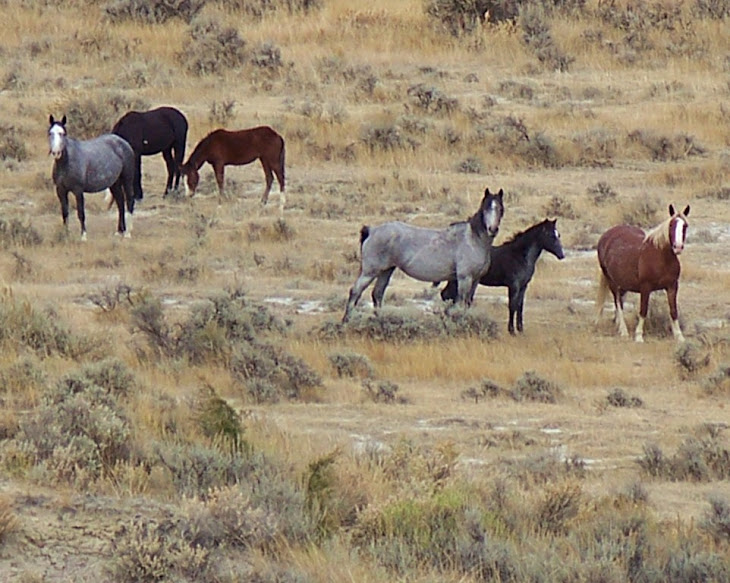
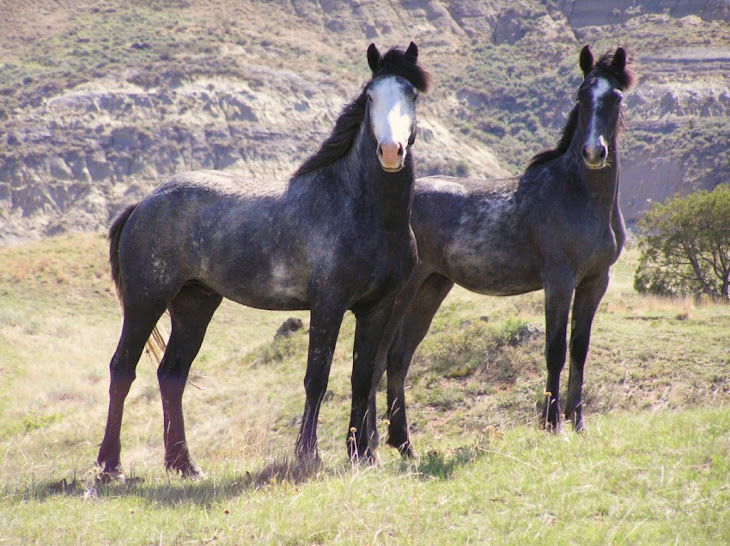









































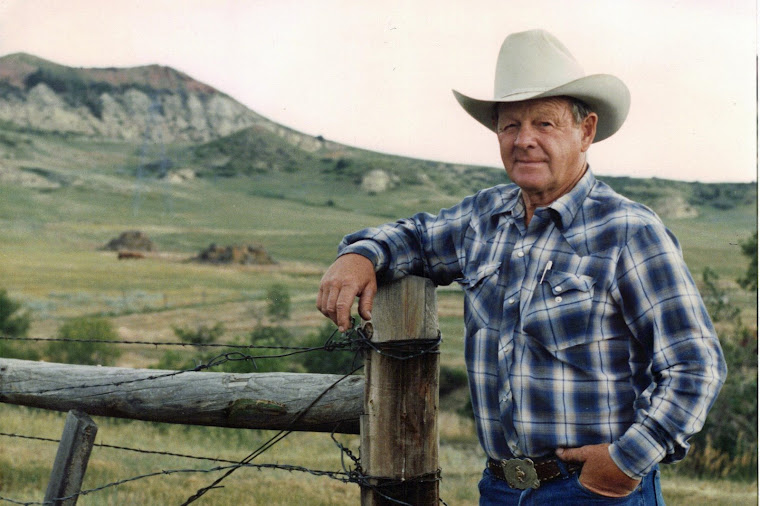
























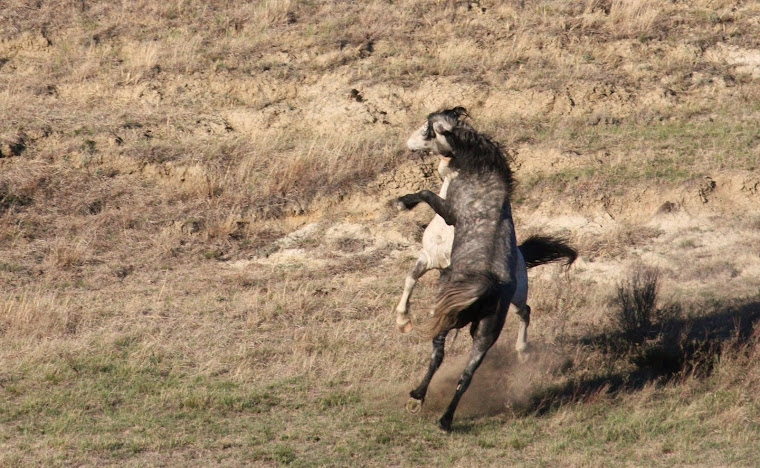













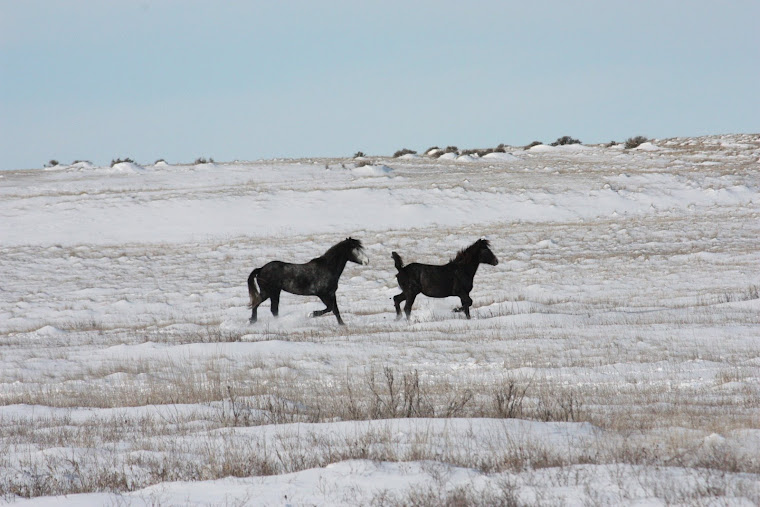
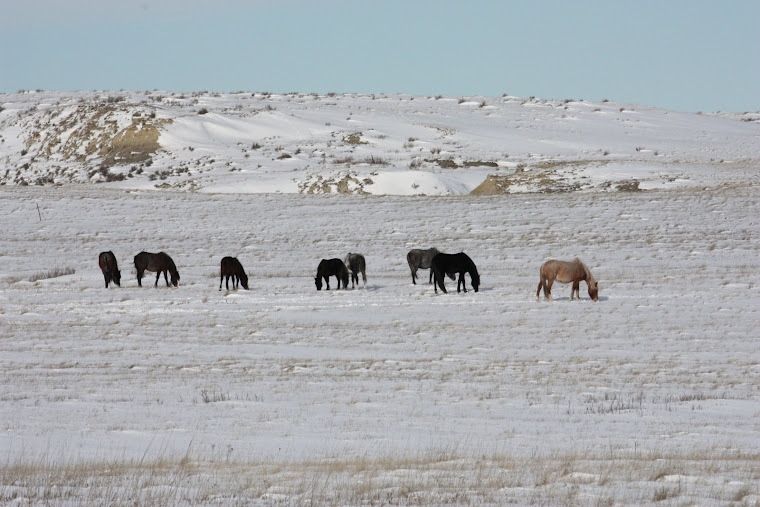
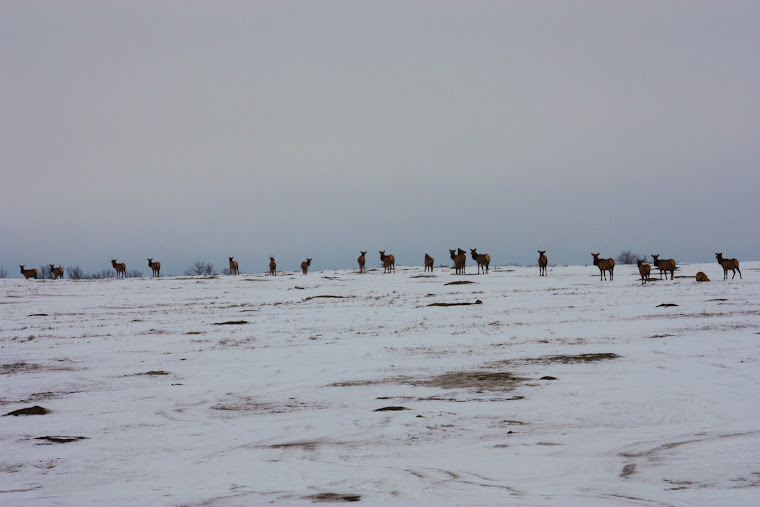
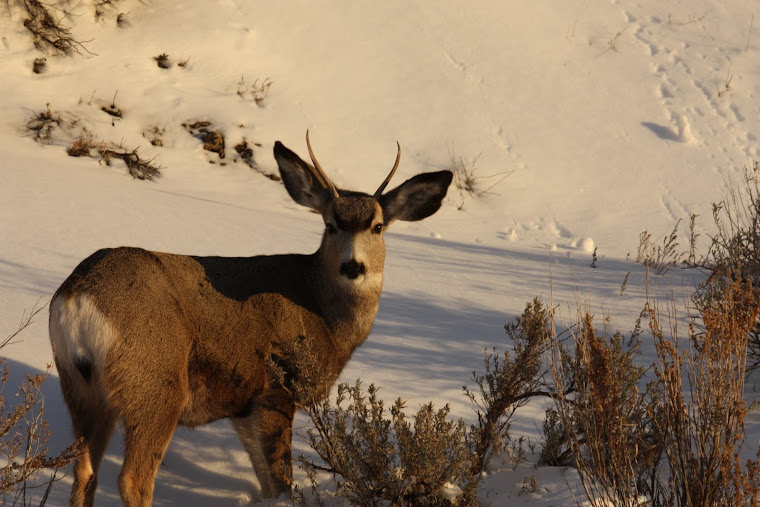




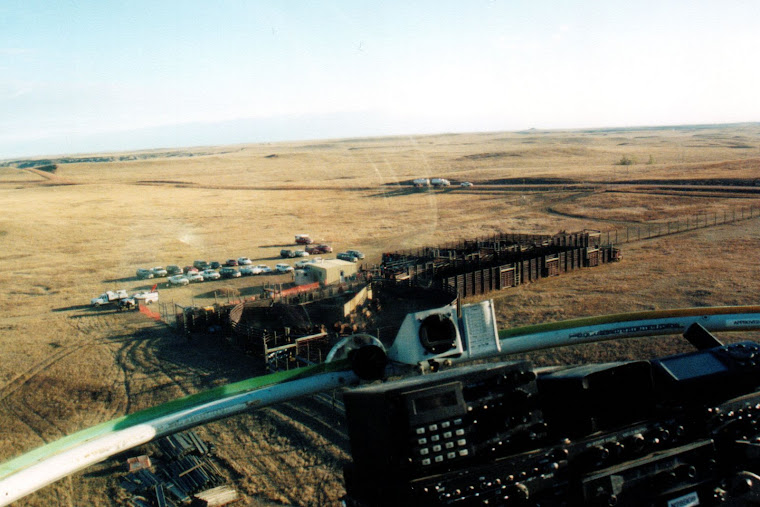
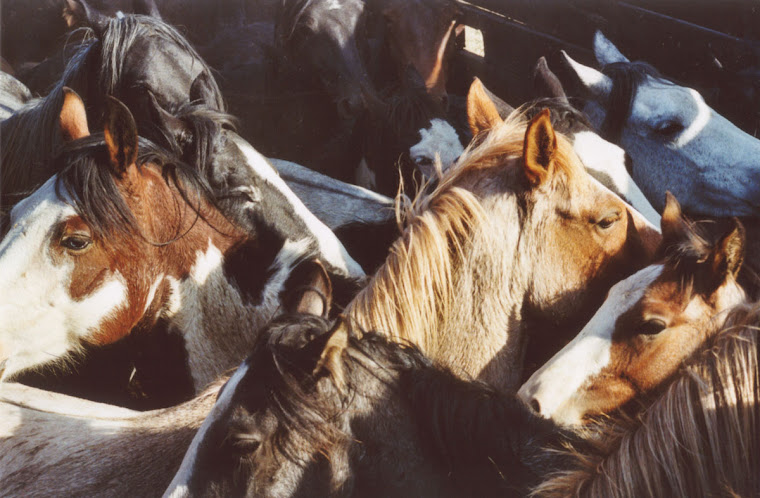
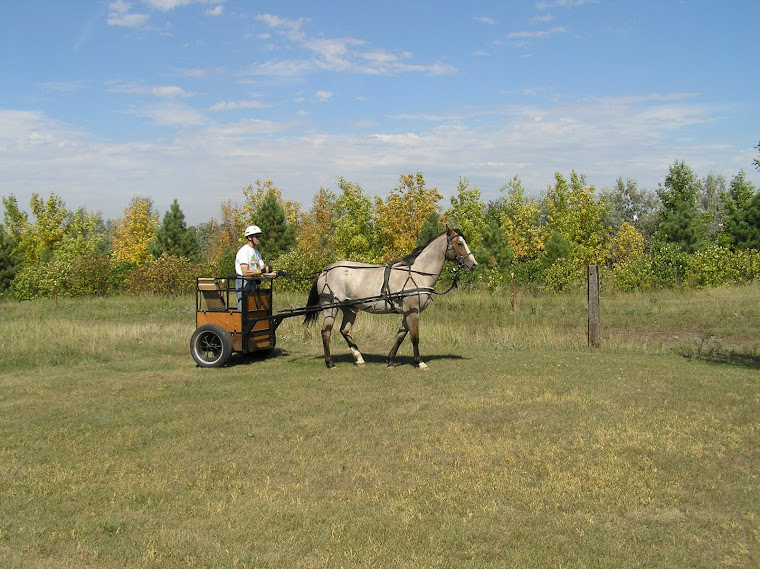
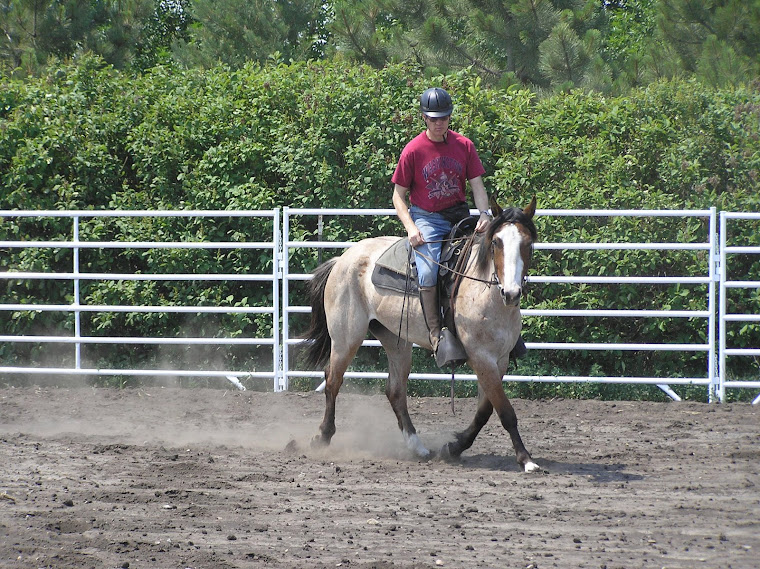

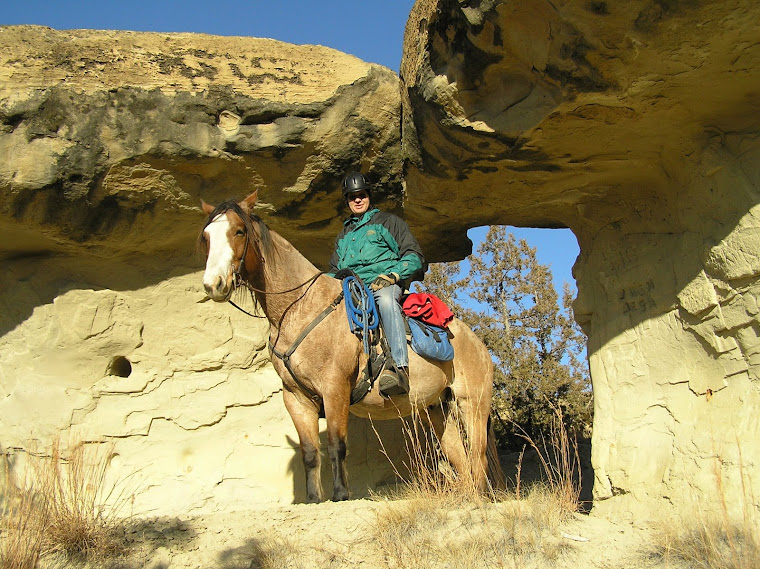



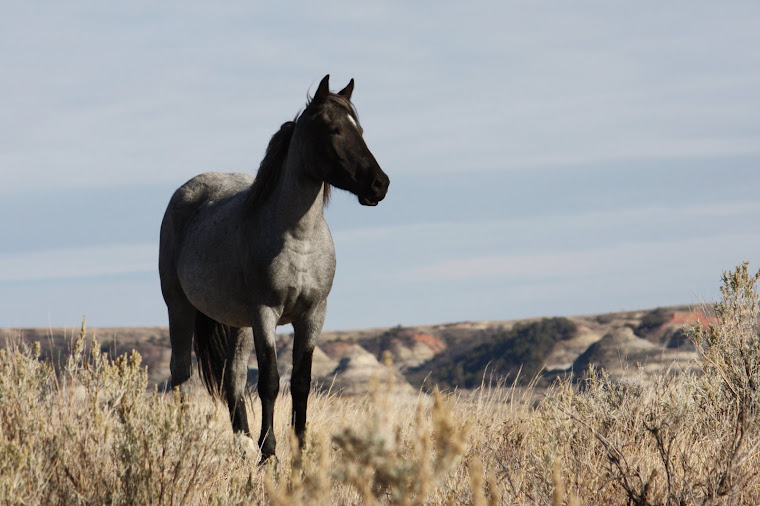


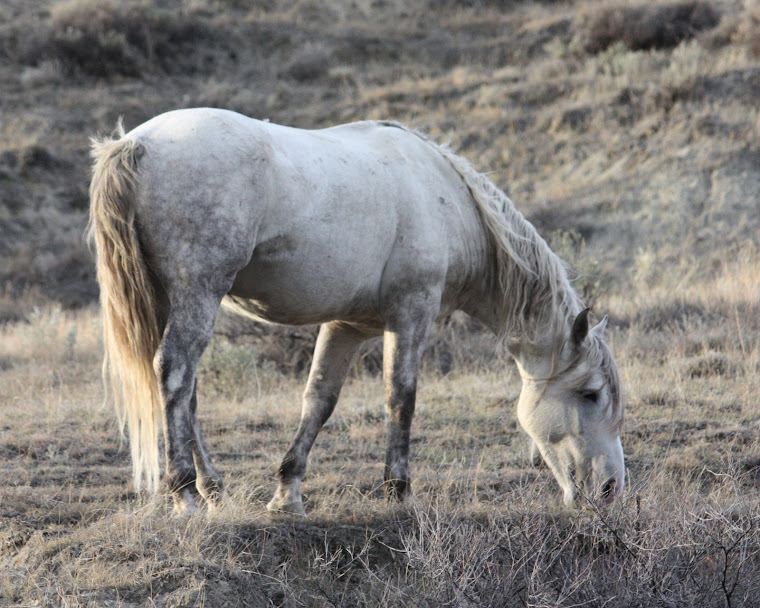
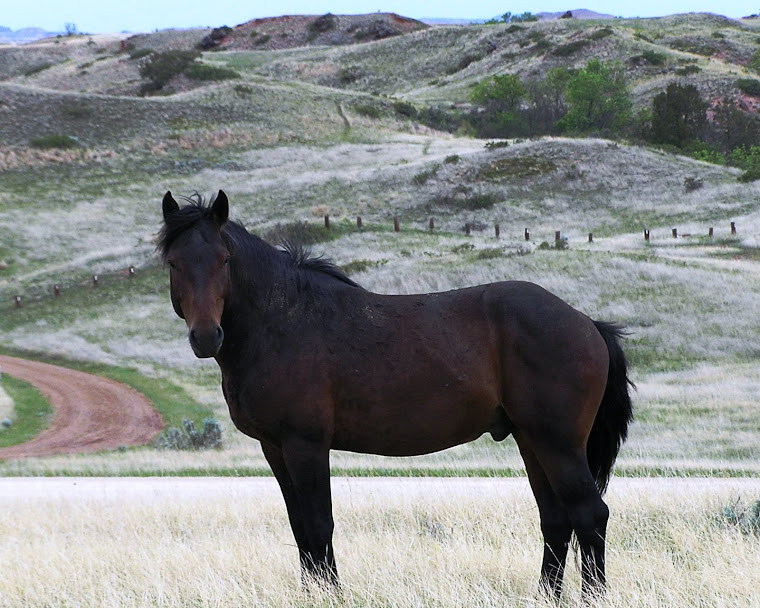

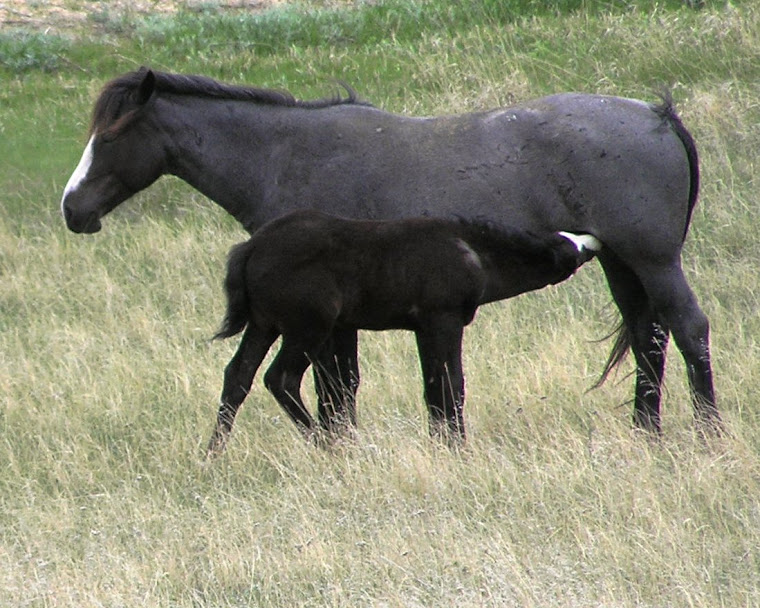

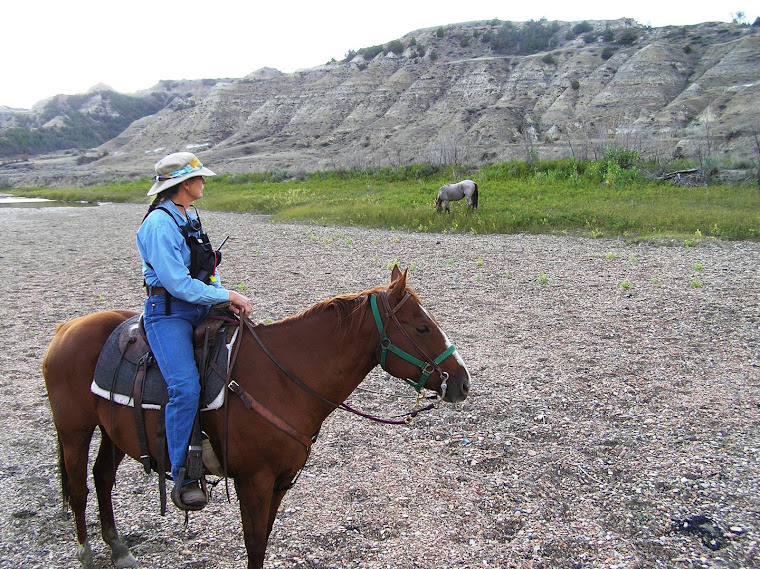
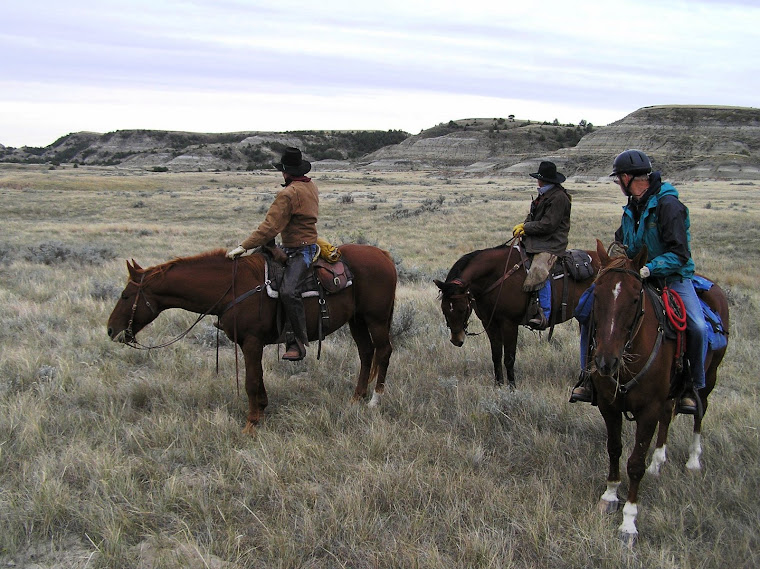
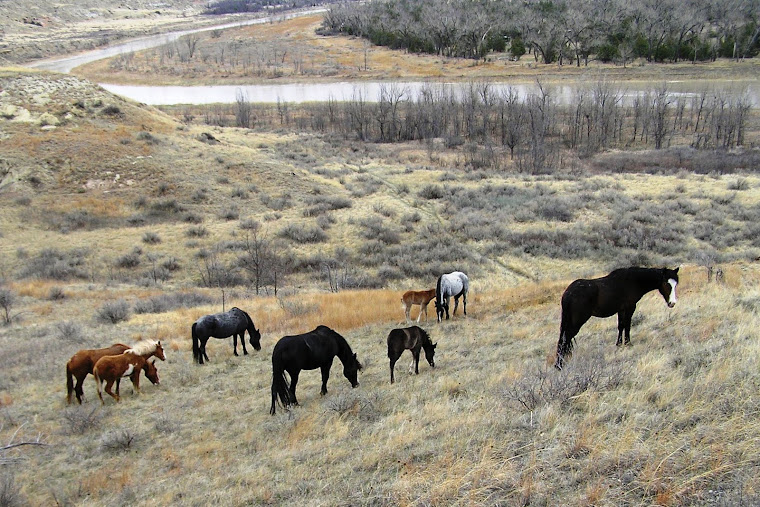
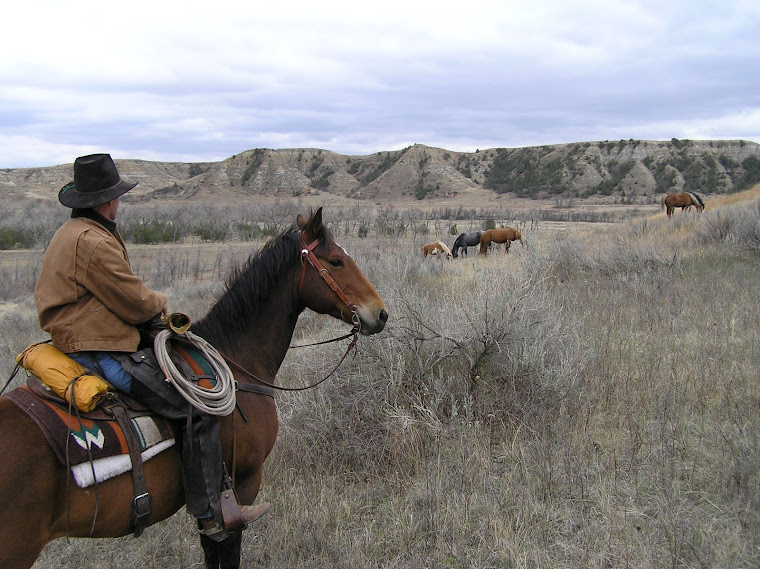

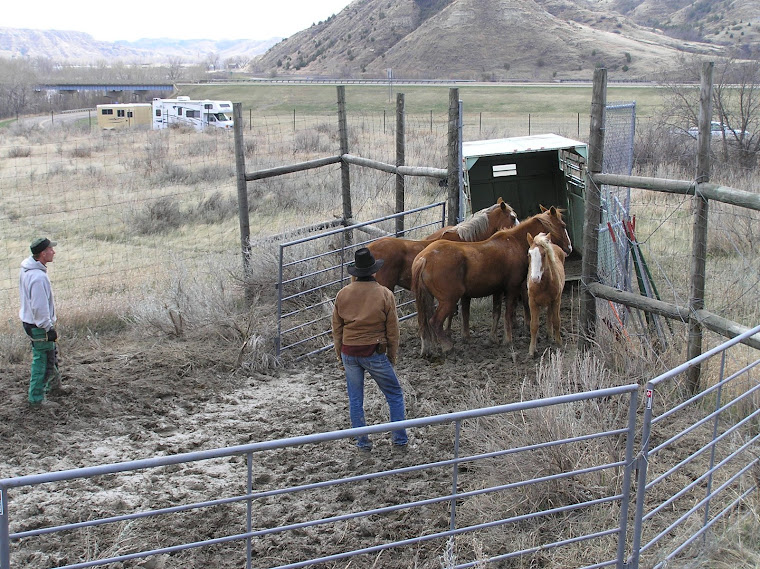
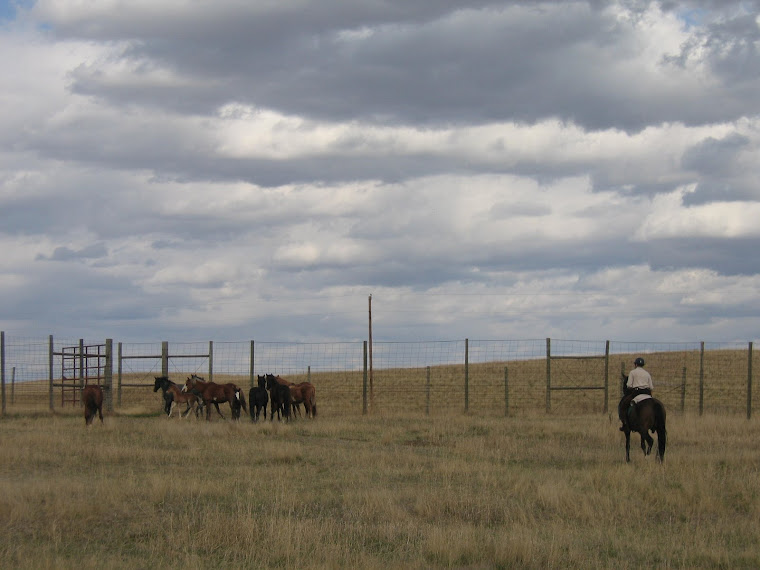
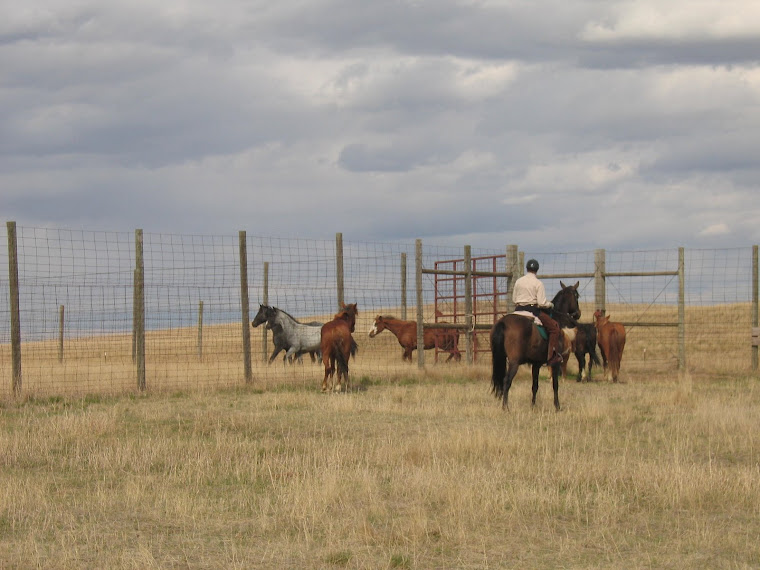
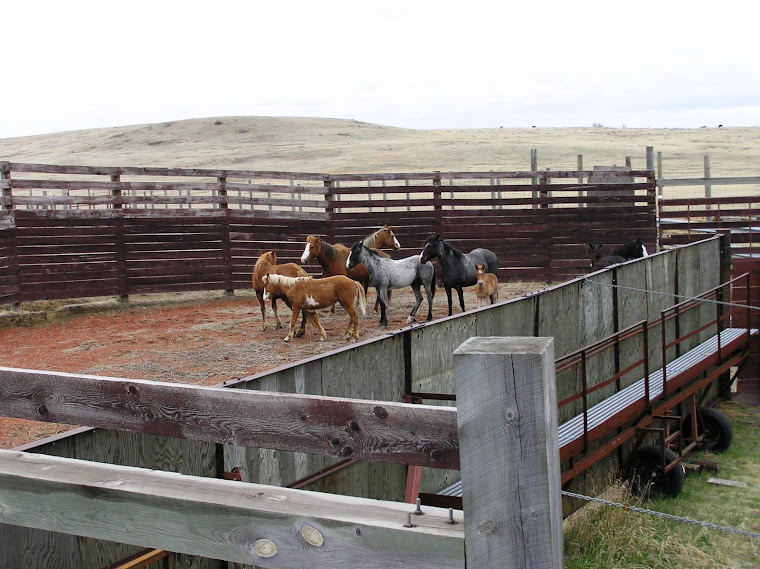


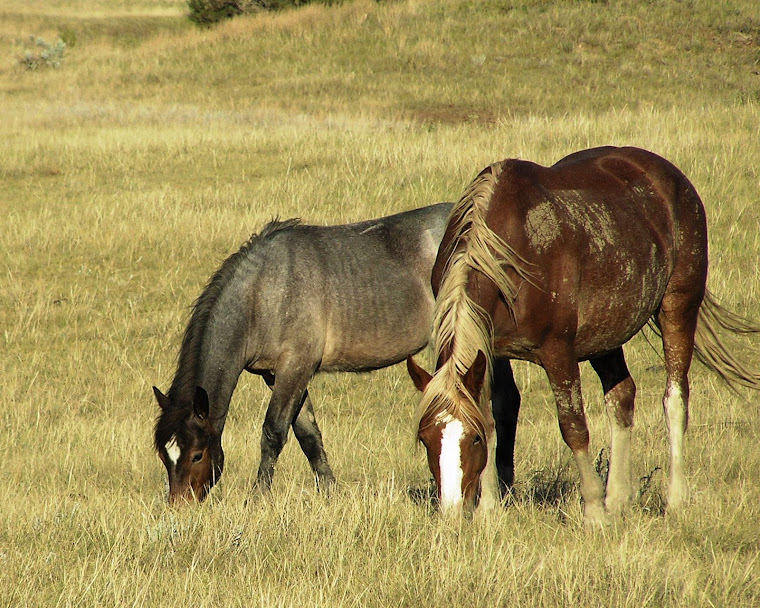

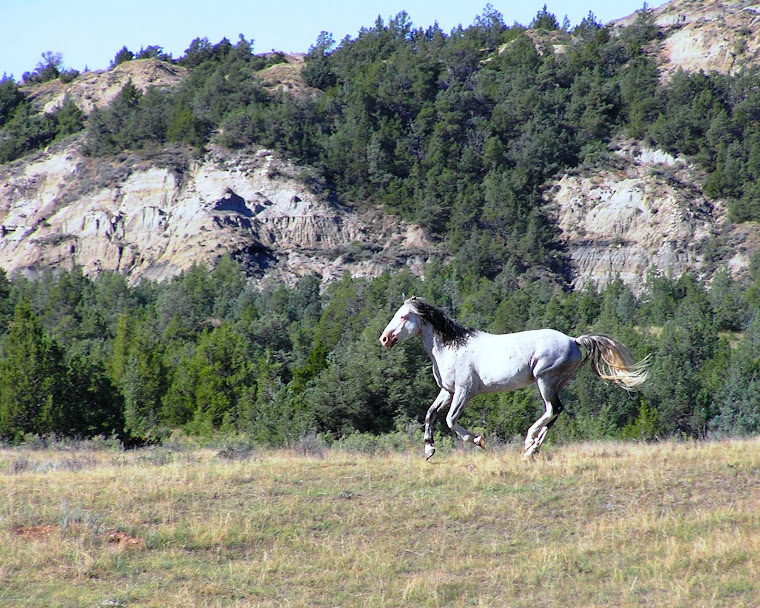
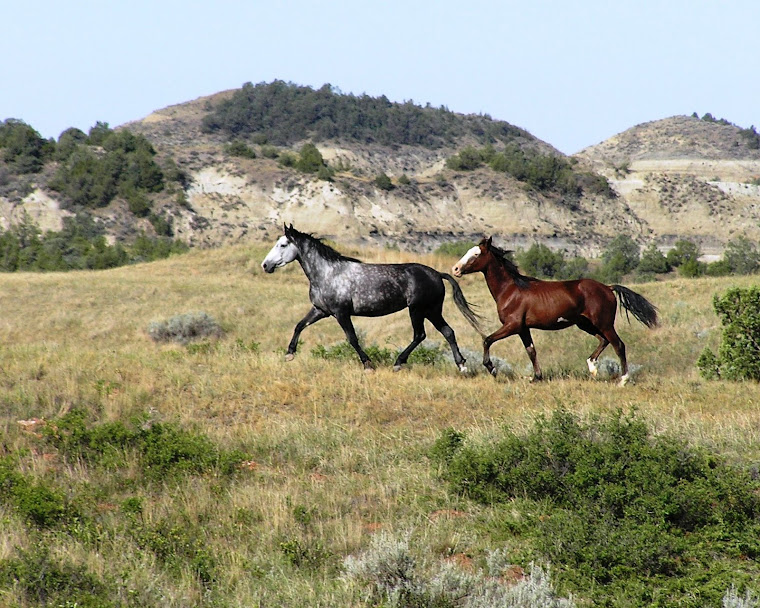
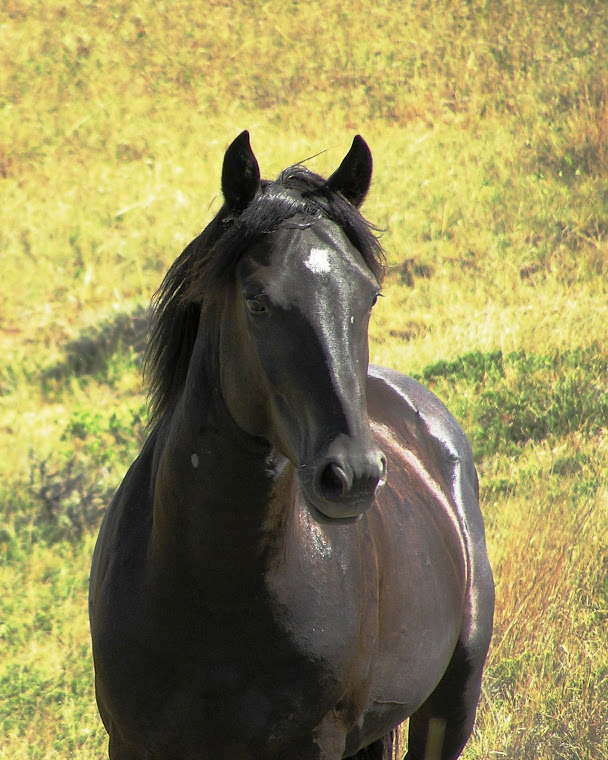

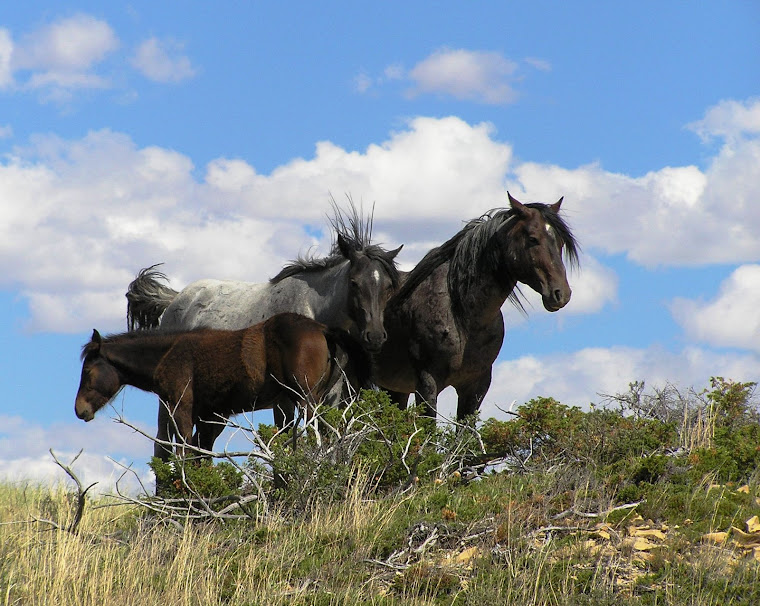



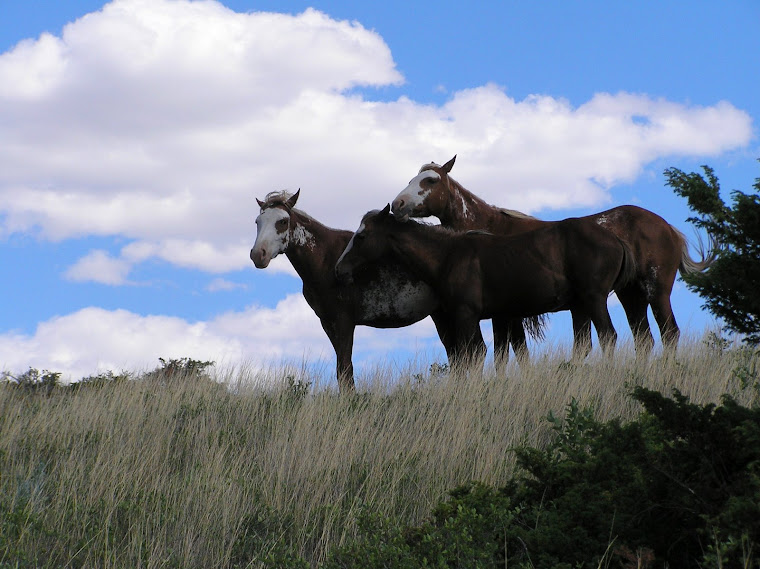


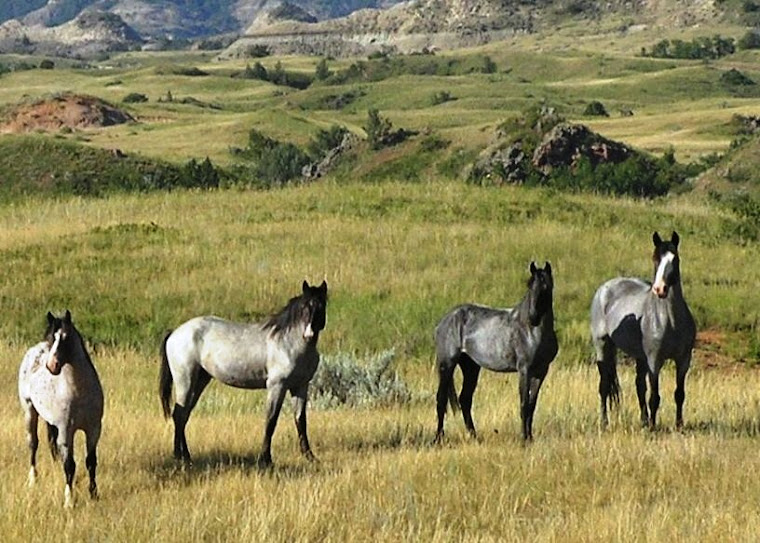
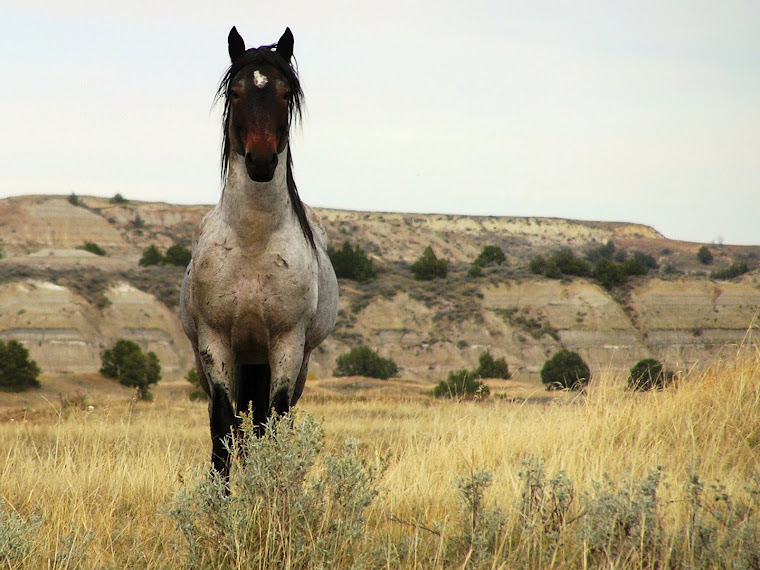
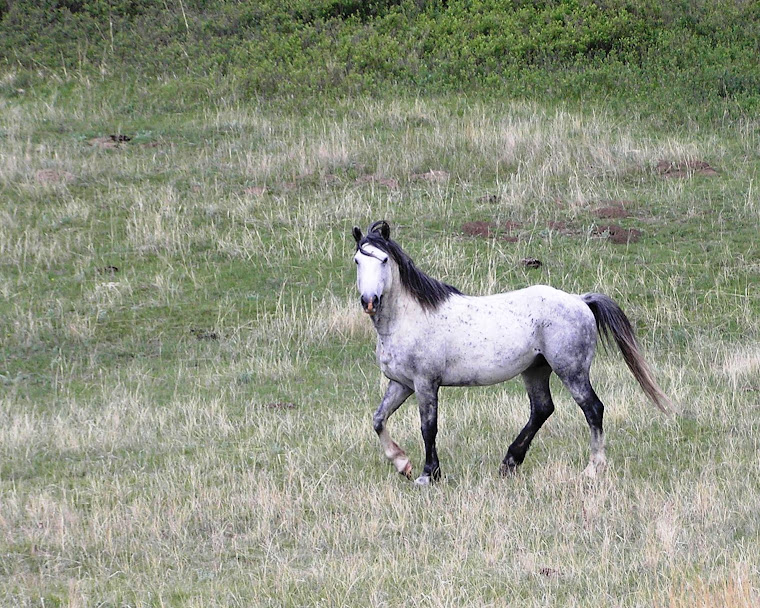

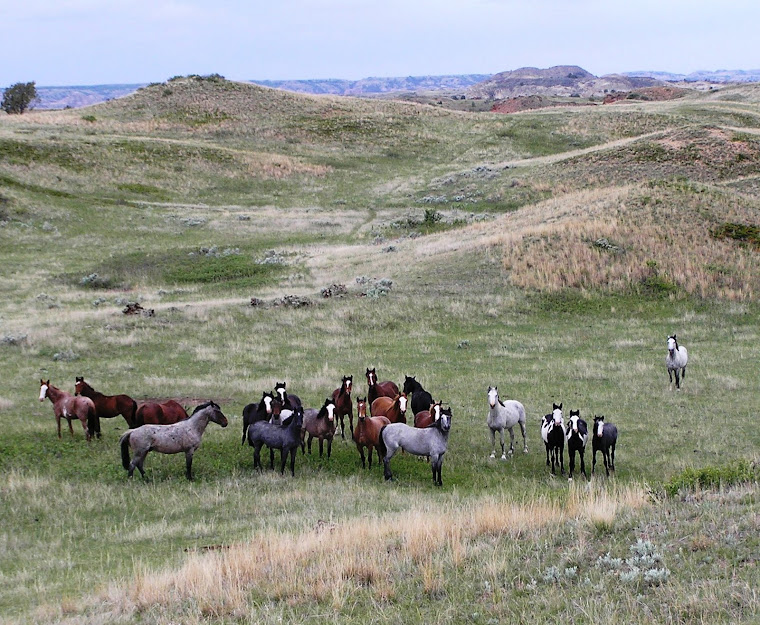
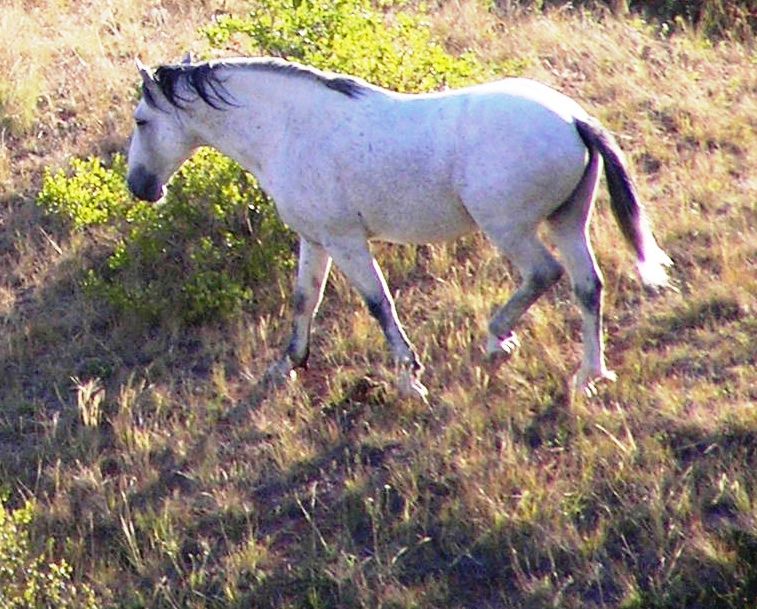
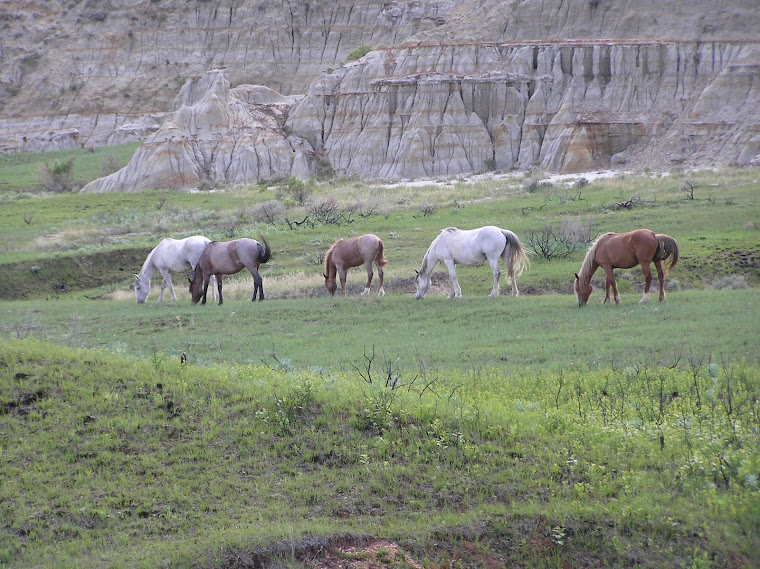
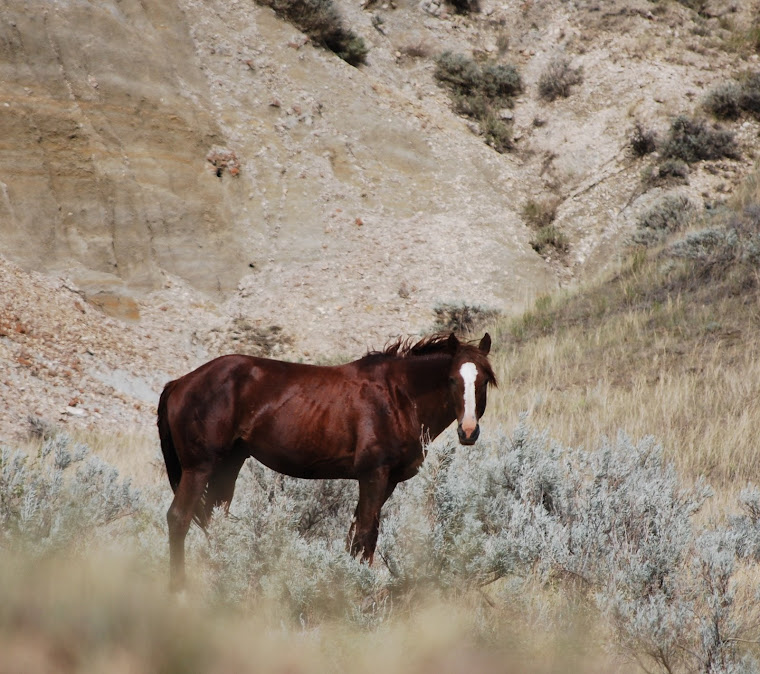

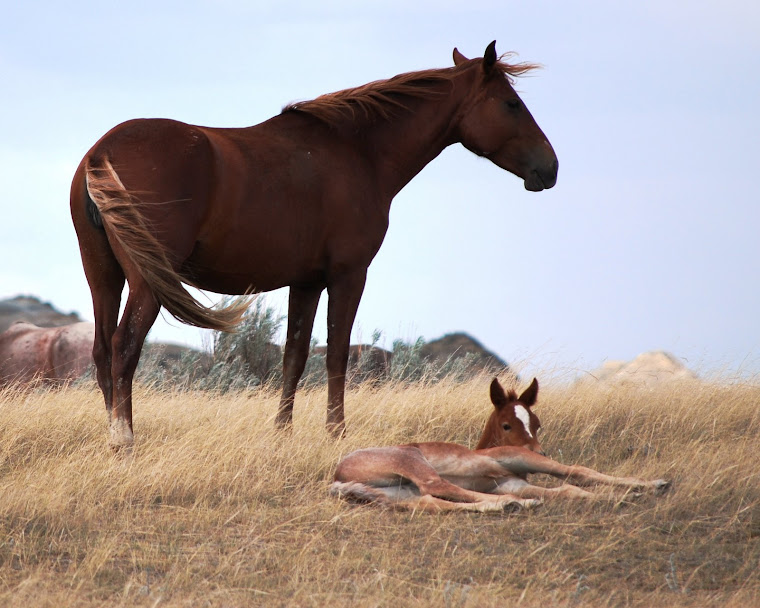
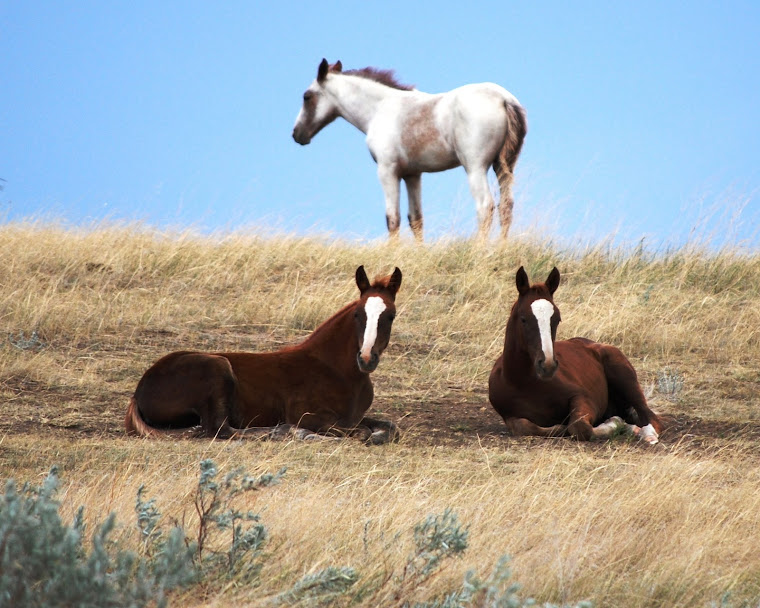
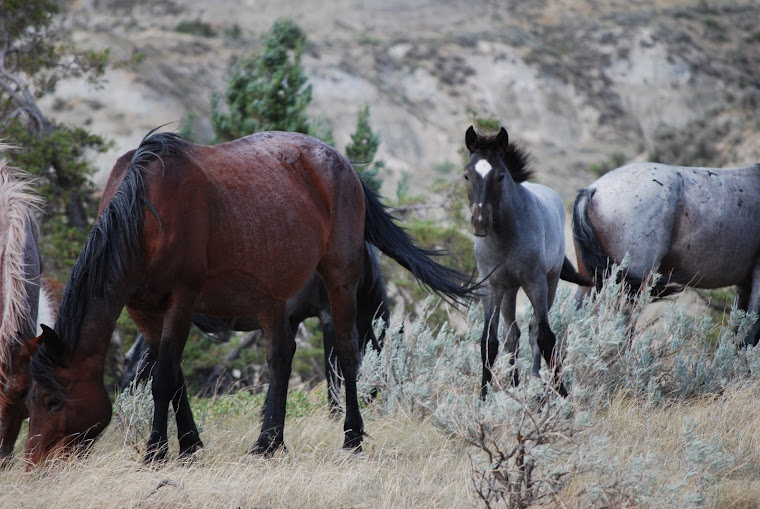

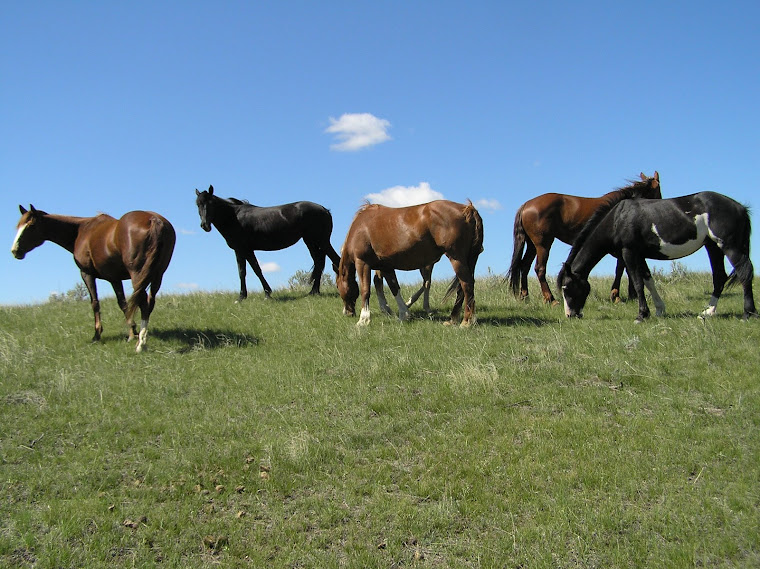
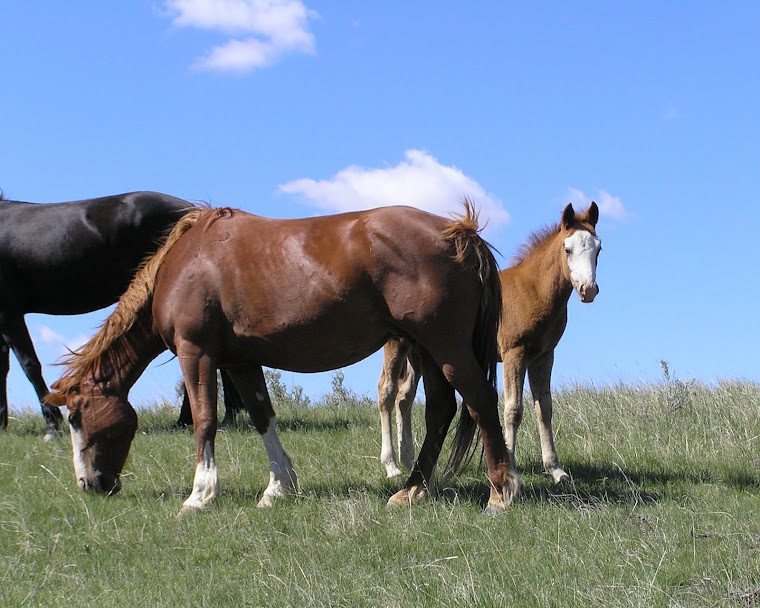

No comments:
Post a Comment